- Stageplaatsen
- Open Day 2024
- Introduction event Hutting 46


Welcome to Hutting Yachts
Since 1975 Hutting Yachts has stood for quality, craftsmanship and performance that has come from a passion for sailing and yacht building.
Start to find your exclusive aluminum sailing yacht, meticulously crafted according to your preferences within our semi-custom range, with sizes up to 55 feet.
We believe that to experience optimal freedom while sailing, you need maximum latitude in creating your dream sailing yacht—whether it involves an extensive refit or the realization of your ideal sailing yacht.
We guarantee the renowned ‘Hutting Quality’ in every detail, from our worldwide service to the highest safety standards inside and outside your yacht, all designed to ensure you experience the true feeling of freedom.
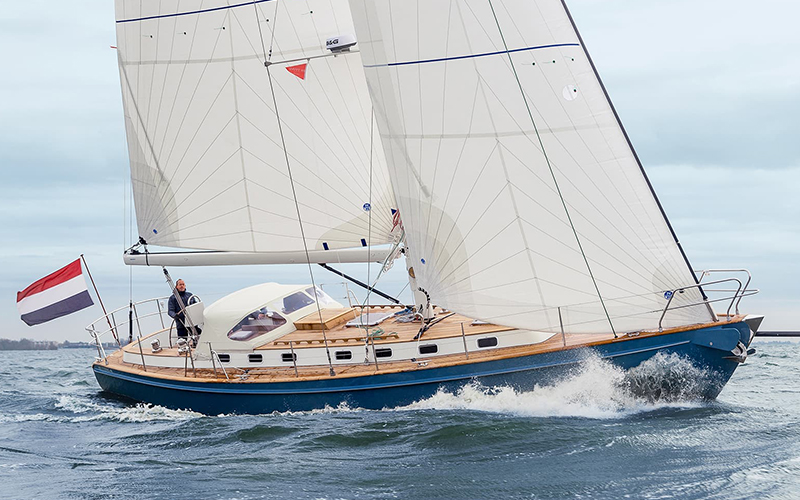
Aluminium Sailing Yachts
Exclusive aluminum sailing yachts. Crafted with high-quality standards and optimal safety in every detail. Ideal long-distance sailing yachts rooted in the core of design, fully customizable to your ideal preferences. A custom sailing yacht tailored to your own desires, sailing style, and travel destinations. Discover our newest sailing yacht: the Hutting 46, and the newest design of the Hutting 52 in cooperation with Hoek Design.
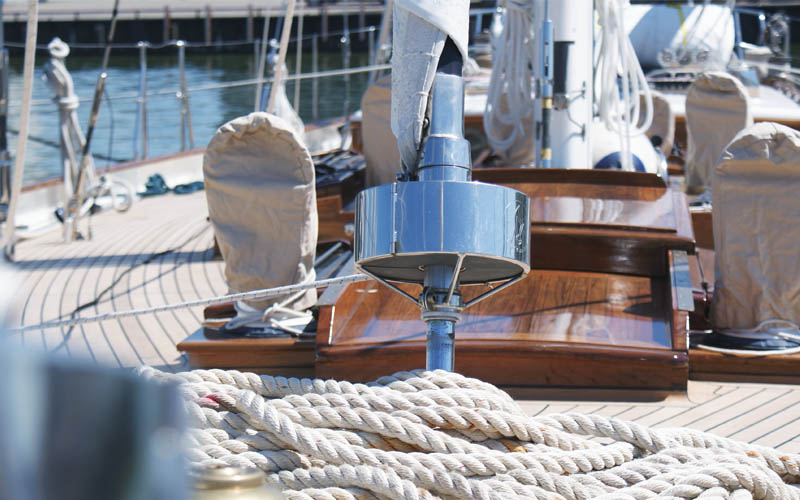
We provide comprehensive refit services from start to finish, with everything conveniently located on one yard—from the mast to the hull and interior. Our goal is to ensure your yacht sails away as new. Additionally, we have the expertise to transform your yacht into an electric or hybrid sailing yacht if desired. Note: we can execute refits for yachts up to 85 feet.
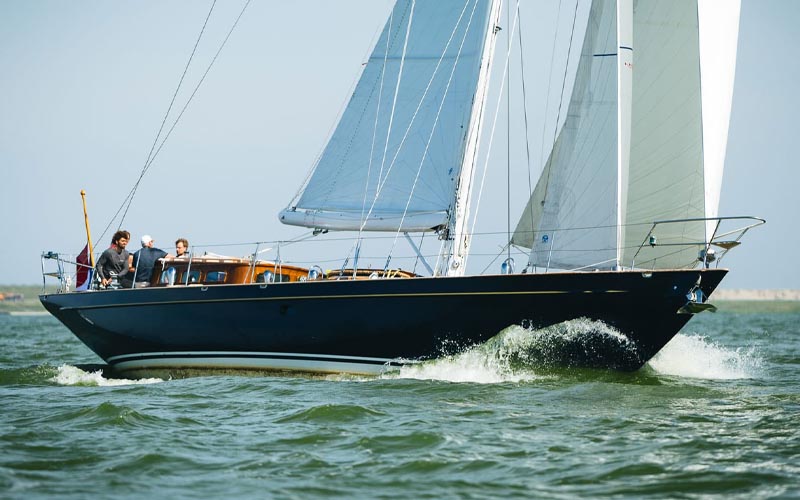
Hybrid Yachts
Together with Stok-electric, we offer completely custom-made solutions for converting sailing yachts into electric or hybrid sailing yachts. We have a suitable, custom-made solution for almost every sailing yacht: from 10kW to 200kW. Prepare your sailing yacht for the future by combining a refit with the installation of an electric or hybrid system.
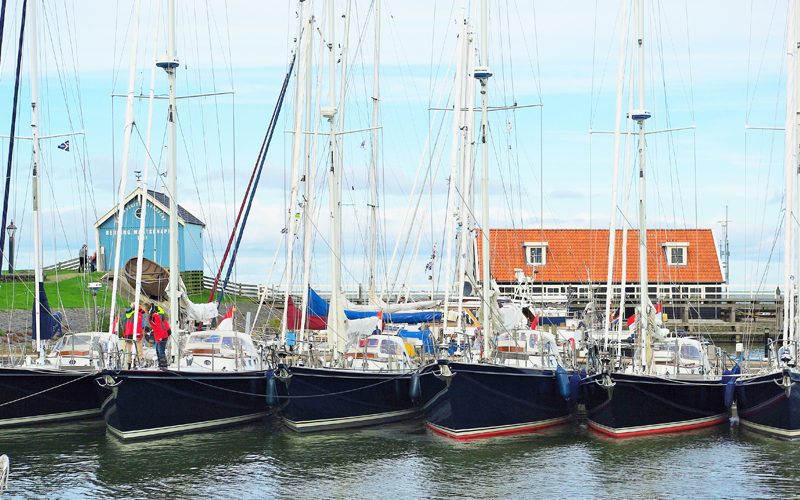
Discover your dream sailing yacht in our selection of luxurious, seaworthy sailboats within a range of 35 – 65 ft. We are here to assist you in your search by leveraging our knowledge, expertise, and international network.
“Keep up the good work on improving the finest dream a man can make in a lifetime”
Y. lafontaine – owner h40, discover the new hutting 46 explorer.
From miles away you recognize the renowned Hutting line from the water. Robust and solid, yet elegant with clearly defined classic lines. The Hutting 46 Explorer; the ideal long-distance cruiser exclusively built to your style.
Latest news
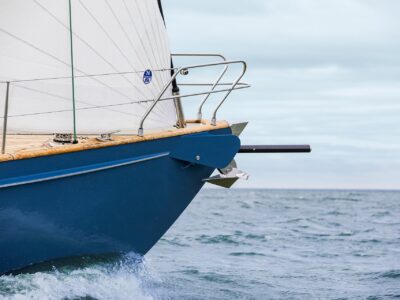
April 13th: introduction event Hutting 46
Be welcome at the exclusive introduction event of the Hutting 46 on April 13 from 2:00 PM to 5:00 PM
8 sailing yacht in brokerage
Discover our expanded range of brokerage sailing yachts, download the brochures, and schedule a view

Festive introductie Hutting 46
Festive introduction of the Hutting 46 during the open day. Watch the after movie here!
Sign up for our newsletter
Stay informed:
- KM Yachtbuilders
The Shipyard
- - Aluminium
- - The People of KMY
- - Custom Yacht Builders
- - Design Process
- - Building Process
- The Services
- - Brokerage
- - Painting Service
- - Customer Care
- - Build Your Own Yacht
- - Bestevaer
- - Sailing Yachts
- - Motor Yachts
- - Visit the Shipyard
- - Partnerships
- - Careers (Dutch)
Growing from less than 10 to more than 40 employees, our yard isn’t same yard it was 20 years ago. Times change and we’re changing with it. What hasn’t changed is our location, the small Frysian village of Makkum. It has been our home from the very start and its down to earth mentality keeps us healthy and focussed.
Home › The shipyard
In a fishing village like Makkum, living with the sea and battling the water have been facts of life for generations. It created a culture of no-nonsense and cooperation that is the foundation for building top quality yachts. After all, if it means the difference between sink or swim, you will make sure to deliver your absolute best work.
The beginning of KMY
KMY is born when Eeuwe Kooi moves from yacht repair and storage to yacht building by aquiring their bankrupt neighbour’s yard.
KMY starts working with DNA
KMY starts working with DNA, Dykstra Naval Architects and the build of Bestevaer 2, Gerard Dijkstra’s personal aluminium yacht really gets things going.
Bestevaer 76S ‘Annagine’
Build of Bestevaer 76S ‘Annagine’ (now ‘Aurelius’) , the biggest Bestevaer to date.
10 year of KMY
Celebrating 10 years of KMY. A year for reflection as well as looking ahead.
As the business grows, the office starts to feel a bit cramped. Time to build a brand spanking new office space.
Delivery of our biggest boat yet, the ‘ Tulip 88 ’, a German Frers design.
Bestevaer 45 Pure
Introduction of the Bestevaer 45 Pure . Our semi-custom yacht build concept.
Build of NanuQ . With her 24 meter, NanuQ (Inuït for polar bear) isn’t our longest, but in volume still our biggest build to date. And as her name suggests she was built for the arctic.
Bestevaer Motoryacht
2020 sees another Bestevaer introduction. This time one without sails: the Bestevaer Motoryacht .
Delivery of Pelagic 77 , Skip Novak’s latest expedition ship, ready to explore the seven seas and beyond.
Design process
Translating the customer’s demands and wishes into a comfortable, reliable and safe yacht is basically what the design process entails. It all starts with listening to the customer, what do they want, what do they need and how can we make that happen.
Heart for aluminium
Aluminium is our material of choice when it comes to yacht building. It is lightweight, strong, stiff, low maintenance and customisable. Moreover, it can be recycled indefinitely.
Between the first contact with a customer and the moment that champagne bottle hits the hull around 50 people have put in their share to create the customers dream yacht. The way we work differs from other companies in the way that we realise every chain in this link is equally vital to have every boat meet our standards. Every part between bow and stern has been thought over, discussed, designed, constructed and assembled by self-managing teams. All of our people, from the yard floor to the design studio, to the administration office, work for the same goal are all equally responsible for getting there.
Building process
A yacht isn’t built in a day. For the future owner it starts when after years of dreaming they decide that the time to have their own yacht built, is now.
Become part of the KM Family
Our team is always ready to assist our yacht owners with advice and assistance in the event of contingencies.
Explore Bestevaer yachts
Designed by one of the world’s most legendary sailors as his private yacht. Brought to you by KM Yachtbuilders.
Aluminium Strongall Specialist – Sailing and motor yachts
Located in Tarare since 1963, META is the manufacturer of Bernard Moitessier's historical JOSHUA. Thanks to the Strongall ® assembly process, patented by the shipyard in 1977, and its unique know-how the shipyard designs and builds sailboats, trawlers, speedboats and other floating buildings using the deck hull prestressed aluminum technique: our constructions are efficient, innovative, comfortable and very resistant.
The History of the Site
It is in Chauffailles, in Saône et Loire, that Jean Fricaud, an enlightened self-taught metallurgist, takes advantage of his workshops to build his first 11m steel motor-sailer: the SAINTE MARTHE. At the age of 13, Joseph, the eldest son, dreams of cars, drawing and mechanics... and of leaving school as soon as possible in order to start an apprenticeship-which he will do, with his father's blessing.
The workshops, in full effervescence, set up a construction line for hydraulic shovels, Joseph finished his apprenticeship as a mechanic in Lyon and left to enrich his technical knowledge in various regional boiler making workshops hoping, as soon as possible, to practice metallurgy on his own account.
Still in Chauffailles, Jean Fricaud is approached by Bernard Moitessier, for whom he agrees, as a good patron, to build the steel hull of JOSHUA. At the same time, Joseph set up under the name META and became a subcontractor for his father's excavator company.
Jean Fricaud, in Chauffailles, has exhausted all the possibilities for expanding his hydraulic excavator construction company and sets up an additional workshop in Tarare, on the RN7, near Lyon. META, still in Chauffailles, began to diversify and expanded its range of construction equipment.
Jean Fricaud seized the opportunity of a lifetime and sold his prosperous business to an industrial group: he had just built the motorboat NADINE and could finally devote himself to deep-sea fishing. But the buyer does not want to expand to Tarare, where the workshop has just been completed. Sensing "the emergence of a market", Jean proposed to his son to build steel boats there. Joseph obeyed and fate precipitated events: thanks to the publicity generated by Bernard Moitessier's exploits, META became a full-fledged shipyard in Tarare.
After having built more than 70 JOSHUAS, more than 30 DAMIENS II, and many other steel hulls, Joseph launches a big paving stone in the pond and abandons steel in favor of STRONGALL® aluminum, which he has just patented. His pre-stressed aluminum construction technique makes it possible to create extremely resistant deck hulls. The young subsidiary PROMETA, directed by François Fevre, also abandons steel for STRONGALL®.
Patrice Passinge is 17 years old when he joins META as a metal worker, under the supervision of André Ravatier, the company's workshop manager. Joseph carefully follows Patrice's efforts, and despite his young age, he soon proves to be an outstanding journeyman.
Patrice Passinge became workshop manager when, after his excellent career at META, André Ravatier took his legitimate retirement. At the end of the 90's, aware that Joseph was getting older, various buyers came forward with the objective of expanding the company. But Joseph wanted to preserve the family spirit of the company and decided to pass on META to Patrice, who had a solid background and an excellent culture of the business.
Joseph definitively transfers the META Chantier Naval Spécialiste du STRONGALL® brand and all its activities to Patrice Passinge.
Construction and launch of FLEUR AUSTRALE, the magnificent custom sailing boat designed for and by Philippe Poupon. This large expedition ketch travels in all the waters of the world in complete safety, from the Arctic to the Antarctic via the Pacific Ocean.
Design and construction of the Ecotroll 39 in partnership with Jean-Pierre Brouns and the Olbia shipyard. The smallest troller approved for ocean navigation, it sailed from Lyon to Greenland through canals and oceans before returning to Lyon via the Canal du Midi in spring 2011.
50 years of META Shipyard on the island of Frioul opposite Marseille. Great meeting with many clients and personalities owning META yachts.
META is diversifying by proposing hulls for various floating projects, such as the development of a floating restaurant (entre deux ô) visible on Roanne.
Based on our floating projects, Dominique Renouf called on META to build Solar Carriage. Real floating habitats with electric propulsion, the Solar Carriage are powered by photovoltaic panels and can navigate on canals and rivers in an ecological way, an important value of our company. In parallel, META is working on its first production boat, the META 36.
Thursday March 12, a few hours before the first presidential address concerning the containment due to COVID-19, Philippe Brabetz signs the takeover of META Chantier Naval Specialist of the STRONGALL®. Patrice Passinge will launch a carpentry workshop dedicated to the interior fittings of the META 36, at the Tarare location.
The takeover is final and the shipyard, renamed META Yachts—Architect Shipyard—Strongall® Specialist, resists to the COVID wave and follows its course. Philippe conceides his TurboKeels® patent to the company and initiates a range of innovative designs for modern, attractive and highly performing sailboats, new motorboats. META Yachts confirms the desire to invest in environmentally clean projects such as electro-solar housing barge carried by Dominique Renouf, and gorgeous Noé boat, carried by Nicolas Lallemand.
Inauguration de META Yachts Services, à Port Saint Louis du Rhône, sur la côte méditerranéenne, cofondée par Philippe Brabetz et Fréderic Switala, pour l'entretien, le gardiennage et la vente de bateaux META Yachts d'occasion.
Technical Legacy
Bernard moitessier, writer of great talent, exceptional sailor and philosopher recognized well beyond our borders, bernard moitessier (1925 – 1994) has become a legend..
He has given rise to strong vocations by communicating his precious philosophy to all those who, in love with freedom, have “taken the plunge” and are blossoming far from our agitated lands. Everything or almost everything… has been said and written about Bernard, a very unusual character. “I am weighing these words because I fear that his formidable genius of simplicity has escaped some people and has disappeared into the oblivion of history, which would be unjust and regrettable. More than any other sailor, Bernard was haunted not only by the obligation of robustness of the boat, but also by maintenance, hence maximum simplicity. In this perfect sailor’s logic, the deck of JOSHUA – by its very studied simplicity – has always constituted, in my eyes, an essential work reference. Today, every builder (amateur or professional) should be inspired by the best of this masterpiece of practical common sense, on aluminum as on steel.
Drastically simple, but with minimum solutions that have been carefully thought through… On the JOSHUA bridge, nothing should catch, nothing should hurt, nothing should jam: no rails or screwed parts, but welding of sturdy rings instead (to make it easier to surf with the brush, to keep everything clean, and to do away with protective adhesives! Moreover, the most economical solutions were the order of the day, because Bernard was really not rich when Jean, my father, built for him in 1961, the hull number 1 of JOSHUA in CHAUFFAILLES. Among the original features of this deck plan – of a monarchal rigor – the famous “Chinese hood” for example, is worth the detour: 100% watertight thanks to its judicious volumes of depression in spite of the absence of flexible joint, inviolable, reducing thermal bridges, it divides by 3 the times of painting on its perimeter while maintaining the aspect of the new: who does better?
I was very young in the trade when my small team of journeymen started the construction of the JOSHUAS in TARARE, and Bernard’s sponsorship was a great help to me!
More than forty years separate us today from the launching of Bernard’s hull in LYON, and the spirit of the master is still deeply rooted in our reflexes – everything that could be tried differently often turned out to be less convincing, so thank you Bernard for your intelligent contribution to the design of the metal decks of our sailing ships.
Joseph FRICAUD
, Founder of META Chantier Naval
Our Strongall ® construction technique
There is no such thing as the a universal or perfect material, and here is why we have chosen aluminum to replace steel:.
- Aluminum boats are solid: constructions are homogeneous, without joints between welded elements and without weaknesses caused by composite associations of various materials
- Aluminum boats have a great longevity, are a good investment when budgets are under control and if they’ve been well designed and especially well built, they maintain a good rating when resold
- Aluminum grades 5083 and 5086 require little maintenance
Why Strongall ® ?
This aluminum construction method was developed and patented by META Chantier Naval in 1977. The concept is that of a self-supporting aluminum deck hull, based on the use of thick sheets: the transverse structure is then reduced to a minimum (integrated tanks, engine cradle, mast belt, crash-box or watertight bulkhead) depending on the size of the boat. This type of construction is synonymous to robustness and longevity, warrants of the significant investment a boat represents over the years.
The Advantages of Strongall ® :
- Stronger than equal weight steel construction
- About 30% lighter than the same steel shell with comparable strength
- The use of thick sheets allows a greater intensity in welding thus eliminating the risk of “sticking”, and guarantees a better fusion of the metal
- Little or no deformation of the plating sheets
- The thickness of the sheets increases the resistance to corrosion and significantly reduces the risk of metal fatigue (repeated cycles of torsion-bending of the planks where the hull is a hollow beam moving on complex waves and swell phenomena)
- The hull is treated with inorganic Zinc Silicate
- The painting of the dead works and the bridge is only necessary for cosmetic reasons, they can remain raw without consequence for the material.
- A significant advantage for the shipowner, the absence of internal restrictive structures makes the design of the fittings more flexible.
Architectural constraint:
The hulls require developable hull surfaces and lively chine(s)—easily integrated in elegant and efficient designs!
Over 300 sailboats, motorboats and trollers have been built in Tarare since 1977, their extreme robustness secures navigation in particularly difficult areas: Arctic, Northwest Passage, Antarctica… COME MEET US IN TARARE, AND GET A FEELING OF WHAT WE REALLY DO!
TurboKeels®
A solution for ballasting lead from one side to the other….
To displace the center of gravity without relying on complex tilting keels, Philippe Brabetz, new owner of the Meta shipyard, has come up with an ingenious solution: TurboKeels®, or how to ballast lead from one keel to another!
Already used on tilting keel sailboats such as IMOCAs, the system literally involves shifting the center of gravity of the boat—but a tilting keel requires a large draft and a complex, expensive and above all fragile mechanism not suitable for cruising yachts.
With TurboKeels®, Philippe Brabetz applies the above basic premise to twin keel boats. The 2 keels are then used as reservoirs to accommodate the ballast which travels from one keel to the other as needed, and following a closed circuit mechanism activated by a simple pump.
The advantages of Turbokeels are:
- Enhances power
- Diminishes heel angle
- Allows for shallow draft
- Simple, reliable and economical
Stronglite®
—The Stronglite ® technique is undergoing scrutiny by our R&D team—
you can stay tuned and follow our social media networks
Philippe Brabetz
Owner & CEO
Nathalie Simon
Administration & Sales
Marin Ducoux
Design Office Manager
Serge Calka
Export & Communication
Johan Tardif
Naval architect, Engineer
Dockyard Technical advisor
Aluminum Ship Builder
Naval Engineer
Philippe Brabetz has an architecture degree from the Paris-La-Villette School of Architecture. While studying to become a building specialist, he attends Dominique Presle’s naval architecture courses and becomes passionate about the subject.
He graduates shortly after the first Gulf War, when jobs were hard to come round, and nevertheless manages to join the Guignols’ team at Canal+, working at the design and production of TV sets and special effects as of 1995. Ten years later, still passionate about shipbuilding, he joins the Nantes Naval Architecture DPEA which he tops by an internship for the construction of America’s Cup Areva Challenge monohull. During his collaboration with shipyards and naval architecture firms in France, Spain and Morocco, he invents TurboKeels: a twin-keel system whose lest is ballasted from side to side. The invention patented, taking over META Shipyard seemed like the next best thing to do.
His mission is to consolidate the achievements of the legendary shipyard, but also to add the creative touch that will allow META to navigate today’s challenging waters and thus continue its fantastic adventure.
Born in the same valley as META and with a name familiar to windserfers worldwide, her career was mapped out: since 2008, Nathalie has been assisting the shypyard’s management from an administrative, commercial and accounting point of view.
An Executive Assistant by training, she favors positions which allow for the widest diversity of tasks, within human scale structures. It is an interactive and stimulating format that she appreciates and that participates to the great complementarity between her very “maritime” professional activity and very terrestrial personal interests: running, cycling, hiking are all activities which fill her up with the energy and enthusiasm we much appreciate.
Nathalie is a valued collaborator, who faithfully has and does contribute to the welfare of the company .
A naval architecture engineer with a degree from ENSTA Bretagne, Marin’s work at META combines his passion for sailing and his experience of ocean cruising with the technical skills acquired through his training.
As an admirer of Gérard Janichon (Damien) and Bernard Moitessier (Joshua), he says he’s proud to be able to contribute to the development of META and its new series of ocean-going yachts, with modern lines and a spirit of adventure still intact.
Lover of nature, water sports, and concerned about the environment, Victor tackles his new adventure : his meaningful collaboration as a fully-fledged member of the META team.
Profil Linkedin
Specialised Masters in Naval and Offshore Architecture/Engineering Offshore engineering, ENSTA Brest
Fluid Dynamics and Energy in Physics, Université Paris-Saclay
Fundamental Physics, Paris-Saclay University
Lionel has learned and confectioned his skill at aluminum ship building at META, where he’s been a faithful member of the team since 2004. He has become the metalworkers’ go-to person for all questions related to Strongall ® boat building techniques.
Not only is he an experienced boilermaker, he’s got a secret skill up his sleeve: he grows grapes which participate in the making of one of the local Rhone wines.
We’re looking forward to the META vintage 😉
Etudiant-ingénieur en architecture navale à l’ENSTA Bretagne, Marin allie en travaillant chez META sa passion pour la voile et ses expériences de croisières hauturières avec les acquis techniques de sa formation.
Admirateur de Gérard Janichon (Damien) et de Bernard Moitessier (Joshua), il se dit fier de pouvoir contribuer au développement de META et de sa nouvelle série de voiliers hauturiers aux lignes modernes et à l’esprit d’aventure toujours intact.
Le chantier est donc très heureux de pouvoir compter parmi ses équipes ce Marin très compétent—mais aussi parfaitement polyvalent, avec un très bel esprit d’équipe et un sourire communicatif.
Anticorrosion
Your anti-corrosion solution for 50 years.
This zinc-based product is the best protection against hull corrosion so far. We are its historical retailer and use it for all of our boats.
Whether used as antifouling or covered by a regular antifouling, METAGRIP ® welds perfectly to the steel or aluminum hull thanks to the absorption phenomenon.
It does not deteriorate and therefore fully respects the underwater environment.
Do you live in metropolitan France ? Order online
You are not in metropolitan France? Ask for an estimate
Subscribe to the newsletter
By entering your e-mail address, you agree to receive our newsletter by e-mail and you are aware of our privacy policy . You can unsubscribe at any time using the unsubscribe links that you will find at the bottom of our newsletters.
Vérifiez votre boite de réception ou votre répertoire d’indésirables pour confirmer votre abonnement.

ELEVATE YOUR EXPERIENCE

BEST OF BOTH WORLDS, HYBRID SOLUTIONS, FUEL SAVINGS

This equilibrium maintains speed when needed, ensuring secure passages, optimal operational economy, unwavering reliability, and zero-fuel serenity at anchor.
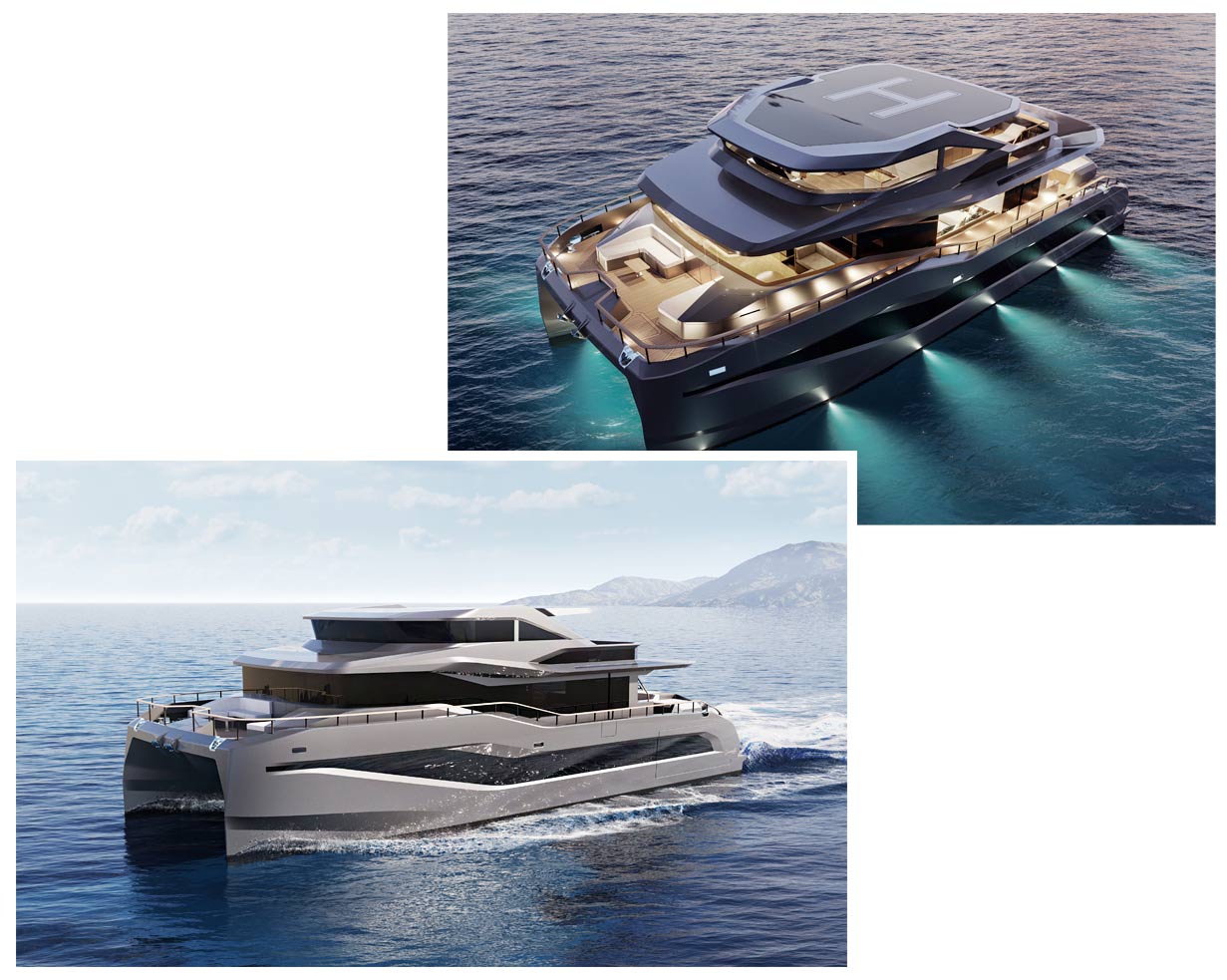
The ocean connection bestows tranquility, adventure, and sustenance, fostering personal well-being and a vibrant lifestyle.
CUSTOM CATAMARAN ALUMINIUM YACHTS
Discover the ultimate in custom catamaran aluminium yachts with Cosmopolitan Yachts. Our passion for excellence shines through in every detail, from the cutting-edge hybrid diesel/electric propulsion system to the meticulous construction using top-grade materials and state-of-the-art technologies.
At Cosmopolitan Yachts, we take pride in delivering superior build quality and attention to every detail, ensuring unmatched durability, performance, and luxury. Our custom catamaran aluminium yachts are designed to excel in any environment, with marine-grade aluminium construction that provides strength, sturdiness, and resistance to corrosion for sailing in any water conditions.
Whether you’re looking for a silent electric boat or speeds of over 26 knots, our custom catamaran aluminium yachts offer ultimate flexibility in power and fuel efficiency. And with advanced hull forms and superior bow height, you’ll enjoy comfortable sailing even in seas exceeding 1.75m.
Embark on a journey of a lifetime with a custom catamaran aluminium yacht from Cosmopolitan Yachts. Let us help you bring your dream yacht to life with our superior build quality, attention to detail, and passion for excellence. Contact us today to start creating the perfect yacht for your needs and make unforgettable memories on the water.
HYBRID-ELECTRIC, HYDROGEN AND FUTURE BIOFUEL AND BIOGASES
At Cosmopolitan Yachts, we’re committed to creating custom catamaran yachts with the latest in propulsion technology. Our hybrid diesel/electric propulsion system offers ultimate flexibility in power and fuel efficiency,but we don’t stop there. We’re also exploring the use of hydrogen and biofuels as a more sustainable alternative for yacht propulsion and all our yachts are classified as “Hydrogen-Ready”. Hydrogen yachts or the use of biofuels and biogas could be the future of yachting, offering an even cleaner and more sustainable, self-sufficient energy source for powering your yacht.
Our dedication to sustainability and innovation means that we’re always looking for ways to reduce our impact on the environment while still delivering unparalleled performance and luxury. With the combined integration of the most advanced electric and hybrid technologies and, with the use of the next generation of fuels such as hydrogen, solar, biogas or biofuels,we can offer the perfect propulsion system to meet todays.
DISCOVER OUR YACHTS
New journeys await.
Discover the ultimate in durability and performance with our catamaran yacht range, designed to excel in any environment. with a robust aluminium construction and hydrid diesel/electrical propulsion system to make the most of the best technological advancements without any compromises.
THE WAY FORWARD
Equipped with either a conventional diesel or a hybrid diesel/electric propulsion system installed in both hulls, each with dual power inputs. This grants Cosmopolitan Yachts the ability to operate silently and emission-free as an electric boat at lower speeds, while still achieving speeds of over 26 knots. Complete redundancy and future proof.
A MAJOR IMPROVEMENT
To create the ultimate catamaran yacht, we have meticulously crafted every aspect with a keen eye for detail, to provide unparalleled performance and luxury. Our yachts are constructed using top-grade materials and state-of-the-art technologies, ensuring durability, comfort, and efficiency.
SUPERIORLY BUILT
The use of high-quality marine aluminium in our yachts not only provides strength and sturdiness but also ensures resistance to corrosion, making it perfect for sailing in various water conditions.
EXCEPTIONALLY DESIGNED WHIT A MAJOR IMPROVEMENT
We believe that every yacht should be a masterpiece, crafted with passion and dedication. Our commitment to quality and attention to detail is reflected in every yacht we build.
UNMATCHED COMFORT
The most spacious interiors, complete with luxurious to create an unforgettable sailing experience. The modern exterior design pays meticulous attention to every detail, including the placement of windows and other features that provide maximum comfort and offer breathtaking views of the surrounding water.
The yacht’s advanced hull form and superior bow height work in tandem to ensure comfortable sailing, even in seas exceeding 1.75m.
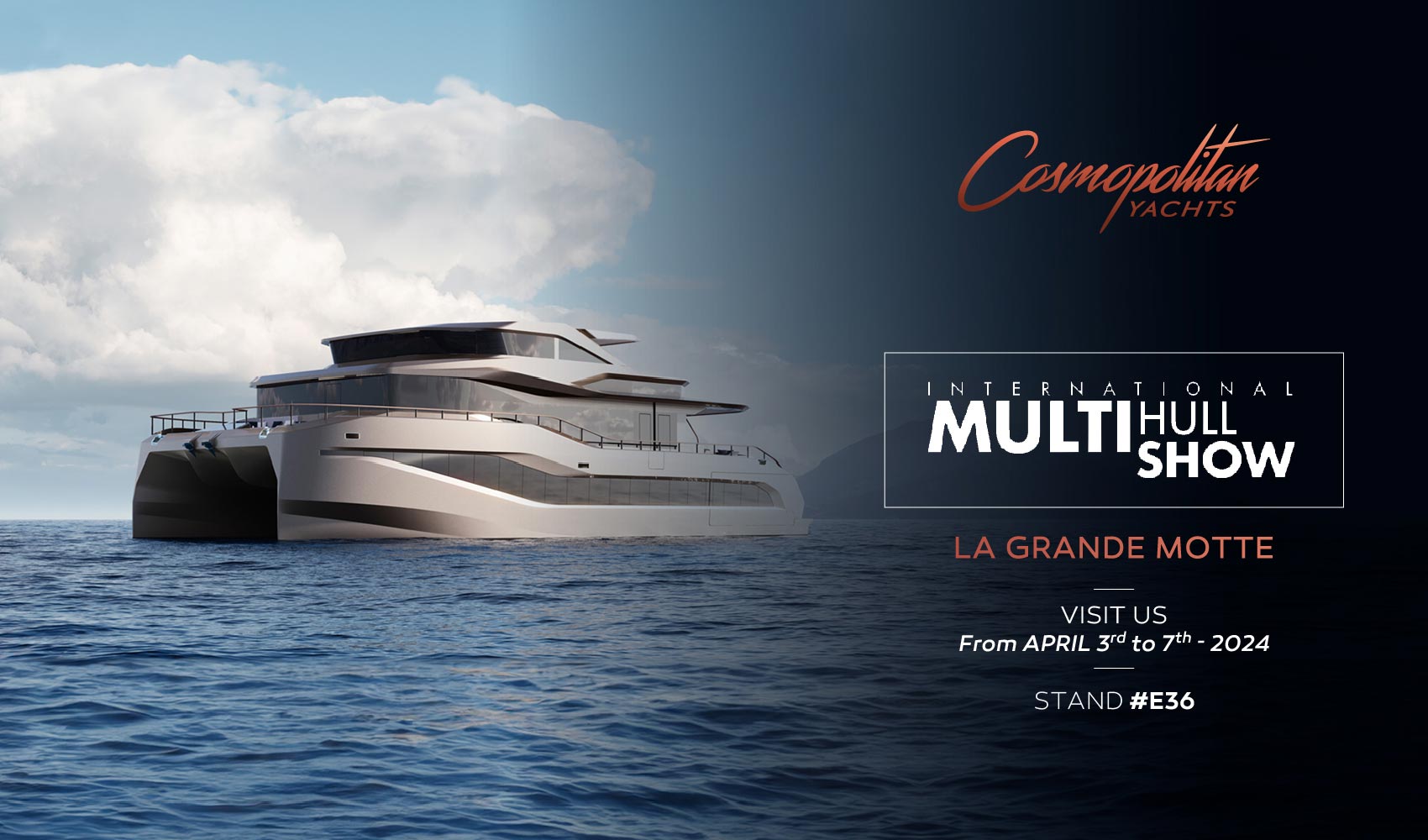
- Alu Marine Yachts
- Inspiration
Alu Marine Yachts has 4 Photos
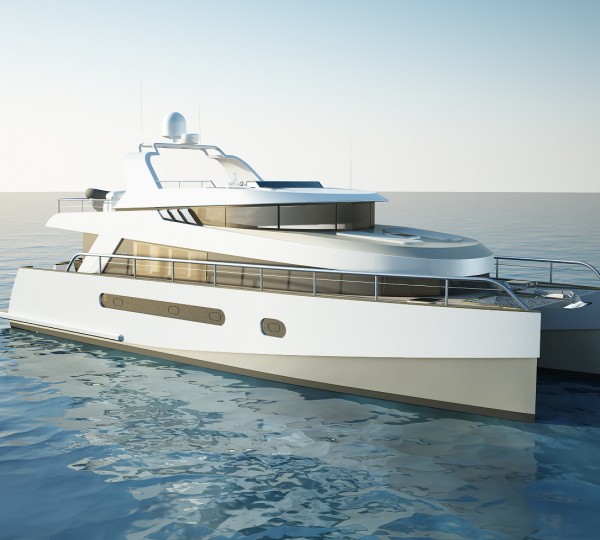
Featured Yachts
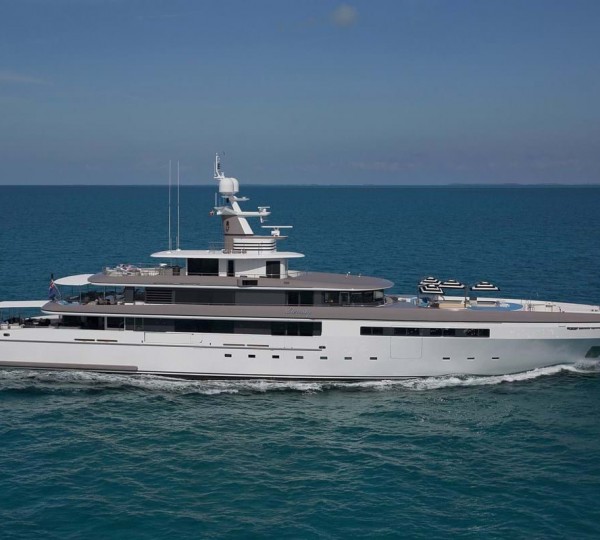
Eternity | From US$ 390,000/wk
Yacht events & boat shows.
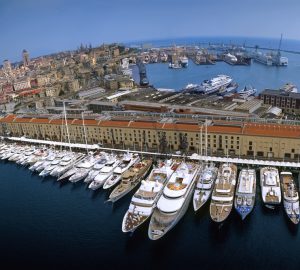
Looking ahead to the 2024 MYBA Charter ...
Alu marine news.
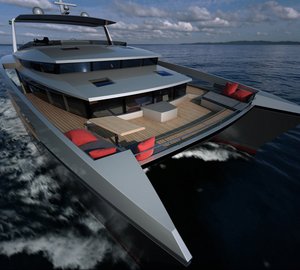
IY&A Awards 2013 Finalists: Alu ...
- Yacht builders & designers >
Alu Marine, a premier yacht building company that was created in 1986, creating bespoke high-end Alu Marine yachts, motoryachts, sailing yachts and high-performance catamarans. It is also a leading manufacturer of industrial and commercial grade aluminium ocean vessels, including passenger ships and ferries, docking boats and barges. There are a number of outstanding Alu Marine charter yachts available for boat rental around the world, with a few of them listed below. For more information and a list of luxury charter yachts that suite your requirements and style, please contact our experienced and professional charter brokers.
The French yacht builder and an active member of Super Yacht France and FIN, is a well-known player in the pleasure yacht and superyacht segments of the industry. Alu Marine employs an experienced and highly-skilled team of craftsmen who are committed to provide the necessary services and expertise in various aspects of the yacht construction project. It also provides regular updates to its clients right up to the projects’ completion and delivery of the newly-built motoryacht or superyacht. In addition to this, the company also performs regular maintenance and refit services to a broad range of clients.
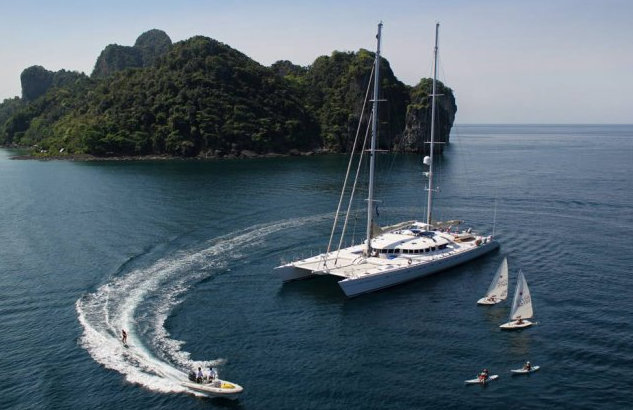
42m Catamaran Dounce France by Alu Marine
Alu Marine in Focus
Since its establishment in 1986, the company was able to complete a diverse set of yacht construction projects, and all of motoryachts and sailing yachts constructed in its facility are still operating in various parts of the globe. The key reasons why high performance yachts and superyachts constructed by Alu Marine yacht builder are highly in demand are their proven stability, durability and comfort.
Alu Marine is supported by highly qualified and experienced team of designers, architects and engineers and specialises in the construction of one-off single-hull and multi-hull yachts. Its construction team is able to adapt to the needs and preferences of their clients, whilst managing a wide range of projects involving power cruisers and sailing yachts. The company is committed to delivering to its clients newly-built luxury yachts and superyachts that meet the highest standards of performance, reliability and safety.
Whilst the main specialisation of Alu Marine is in the construction of sailing yachts and motoryachts with aluminium hull, the company has diversified its core specialties to cope with the rising demand by sailors and professional maritime entities for a wide range of motoryachts and sailing yachts. A significant milestone in the growth and expansion of the company is the construction of super yacht Douce France , which is a high-performance 138-footer catamaran. The catamaran Douce France was hailed by maritime experts as the largest sailing vessel in the world (at the time of her launch).
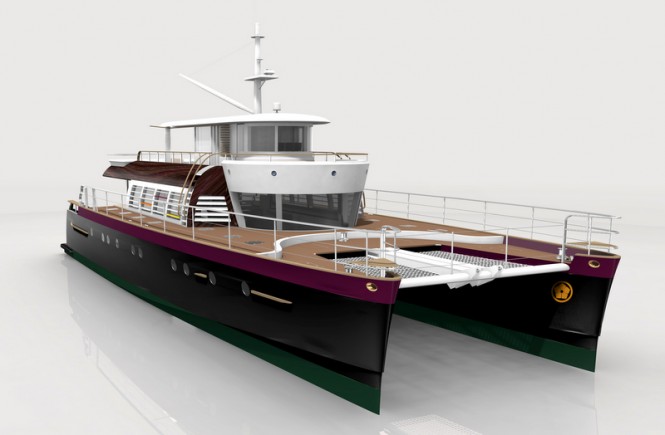
Photo 1: Alu Marine catamaran yacht Noah 88 design by Kenzo Takada; Photo 2: Luxury catamaran yacht Noah 70; Photo 3: Luxury power catamaran yacht Panama 62' concept;
A Look at the Major Milestones of Alu Marine
In 1986 there was the growing preference for larger motoryachts and superyachts and an increasing number of yacht builders were channeling their resources and using their expertise in constructing megayachts and large vessels.
It was during this year that Alu Marine completed their first yacht construction project, the catamaran Douce France, considered then as the largest luxury catamaran. In 2005, Jean-Claude Borgel got majority control of Alu Marine and gave a fresh direction to the yacht building company.
It was in 2009 that Alu Marine formally opened its new shipbuilding facility. This ultramodern and high-performance yard increased the production capacity of the company and provided a better working environment for its team of engineers and technical personnel. It was also during this year that Richard Gibeaud was appointed as the company’s general manager.
2010 was relatively a busy year for Alu Marine. It was during that year that the company launched the biggest industrial-grade barge that was ever constructed by Alu Marine. The company also launched its Havana yacht line, which is a collaborative project between Alu Marine and eminent yacht designer, Berret Racoupeau .
Alu Marine Charter Yachts
Below is a small selection of Alu Marine charter yachts available for yacht rental in different charter destination around the world. For more information and a full list of yachts that suits your needs, requirements and style, please, contact our professional and experienced charter brokers .
- Yacht builders & designers
- New Superyachts Launched
- Luxury yacht designers
- Abeking & Rasmussen
- Acico Yachts
- Admiral Yachts
- ADA Yacht Works
- Aegean Yacht
- Alstom Yachts (Aker)
- Alloy Yachts
- Amels Yachts
- AM Shipyard Yachts
- Atollvic Shipyard Yachts
- Arcadia Yachts
- Azimut Yachts
- Baia Yachts
- Baglietto Yachts
- Baltic Yachts
- Bilgin Yachts
- Blohm & Voss Yachts
- Bloemsma Van Breemen
- Burger Yachts
- Cantieri di Pisa Yachts
- Carbon Ocean Yachts
- Cheoy Lee Yachts
- Christensen Yachts
- Claasen Shipyards
- Cobra Yacht
- Codecasa Yachts
- Couach Yachts
- Damen Yachts
- Danish Yachts
- Delta Marine
- Derecktor Yachts
- Devonport Yachts
- Dominator Yachts
- Dream Ship Victory
- Dubois Yachts
- Dunya Yachts
- Ferretti Yachts
- Fincantieri Yachts
- Filippetti Yachts
- Fountaine Pajot
- Hakvoort Yachts
- Hargrave Custom Yachts
- Hatteras Yachts
- Heesen Yachts
- Horizon Yachts
- Holland Jachtbouw
- Icon Yachts
- Jongert Yachts
- Leopard Yachts
- Mangusta (Overmarine)
- Marco Yachts
- Mondo Marine Yachts
- Moonen Yachts
- Mulder Shipyard
- Nautor's Swan
- Nobiskrug Yachts
- Oyster Yachts
- Palmer Johnson Yachts
- Pendennis Yachts
- Perini Navi
- Princess Yachts
- Turquoise Yachts
- Rossinavi Yachts
- Royal Denship
- Royal Huisman Yachts
- Sanlorenzo Yachts
- Silver Yachts
- Southern Wind Yachts
- Sunreef Yachts For Charter
- Sunseeker Yachts
- Timmerman Yachts
- Trinity Yachts
- Wally Yachts
- Recent Launches
- Yaretti Yachts
Quick Enquiry
Douce france | from eur€ 95,000/wk.
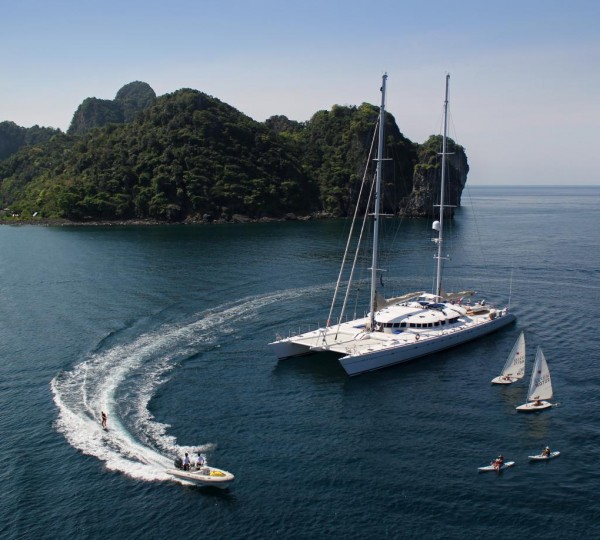
JAIPUR | From EUR€ 11,000/wk
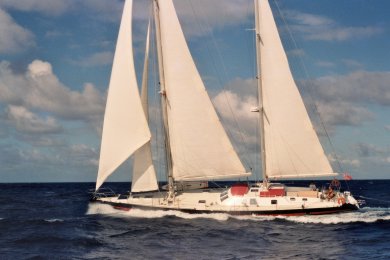

Alu Marine Superyacht News
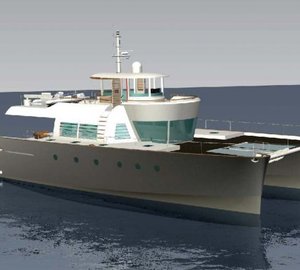
Alu Marine’s luxury catamaran yachts ...
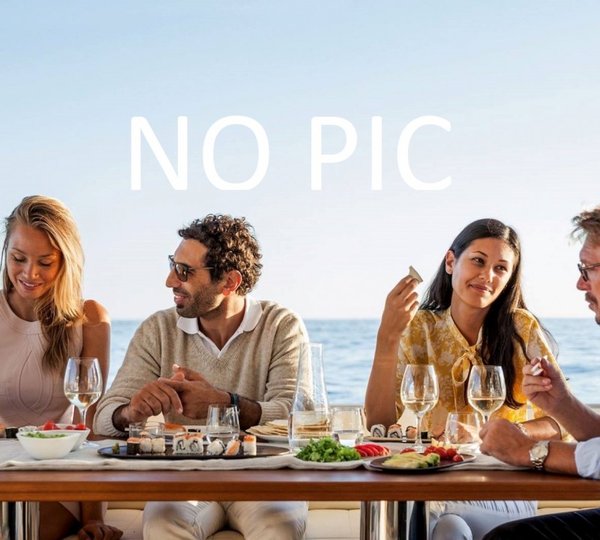
Video of the 42m Alu Marine luxury ...
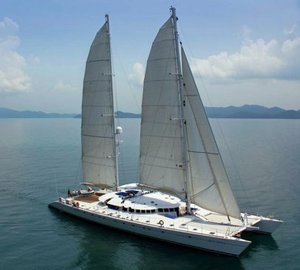
Spectacular and timeless charter ...
Yachting World
- Digital Edition

First look: Ovnicat 48 aluminium multihull
- Rupert Holmes
- April 26, 2022
The inevitable combination of both the trend for aluminium yachts and towards multihulls, the Ovnicat 48 is a new go anywhere catamaran, Rupert Holmes reports

It’s easy to assume that all rugged metal yachts are very heavy. While that was the case at one time for steel designs, it’s a different matter for aluminium which, before carbon fibre became feasible, was frequently used for competitive racing yachts and from which the Ovnicat 48 is built.
This means it was almost inevitable that two of the biggest trends in cruising yacht design – expedition yachts and multihulls – would merge at some stage. The Garcia Explocat 52 , launched late in 2020, wasn’t the company’s first aluminium catamaran, but it brought the concept to a bigger audience.
At the same time Ovni, which has built 1,500 shoal draught aluminium monohulls over the past 50 years, was also developing a multihull concept with a 48 design. The first two have already been sold, with one scheduled to launch in 2024.
We don’t yet have many details, but it looks like an enticing design by Mortain and Mavrikios, with more of an emphasis towards warm water sailing and temperate climates than the other yachts in this selection.
Despite the boat’s rugged nature, laden displacement is lower than that of most cruising catamarans of similar size, giving the promise of brisk and enjoyable sailing without the worries of a more fragile fibreglass construction.
Ovnicat 48 specifications
LOA: 14.50m / 47ft 6in Beam: 7.75m / 25ft 6in Draught: 1.35m / 4ft 5in Base price: €1,200,000 ex VAT Builder: alubat.com
If you enjoyed this….
Yachting World is the world’s leading magazine for bluewater cruisers and offshore sailors. Every month we have inspirational adventures and practical features to help you realise your sailing dreams. Build your knowledge with a subscription delivered to your door. See our latest offers and save at least 30% off the cover price.

Be Bold. Be Antifragile.

Don't miss another video, subscribe to our channel
Alubat [al.u.bat] noun | Aluminium Bateau | Aluminum Boat

Open House at Alubat
Join us at the Alubat boatyard in Les Sables d’Olonne, France for our Open House this coming May 31 to June 1 and get on board a new OVNI 370 and OVNI 430.

Amazing 43-ft Aluminum Sailboat
Full-time cruisers Roberta and Duca stopped by to visit us during the La Rochelle Boat Show for a tour of the NEW Ovni 430.

The ‘Small’ Huge Sailboat
Tour of the new Ovni 370 with Duca and Roberta on their YouTube channel Odd Life Crafting.

Aluminum Sailboat Misconceptions
“I have a friend, who knows a guy, who has a cousin, that bought an aluminum boat, and after a week in the marina the bottom fell out of her”.

Alubat Pricing
How Much Does a Well-Equipped Alubat Ovni Cost? Find out how we price the Ovni range of aluminum sailboats for the serious off-shore cruiser.

OVNI 490 Preview
The 490 shares some of the hallmarks of the Ovni range: shaft drive, full sailplan, centerboard, and spacious interior with a raised salon layout.

50 years of sailing excellence!
FIGARO nautisme | by François Tregouet
Half a century old and still thriving, Alubat, the Vendée-based shipyard, is not content with just being one of the world’s benchmarks in ocean cruising with its iconic Ovni yachts. Instead, with the enthusiasm of youth, it is preparing to launch three new monohulls over the next two years.
Link to read article [PDF]
STRENGTH ACROSS THE FULL RANGE OF ALUBAT Aluminum SAILBOATS

The new generation OVNI 370 with an inverted bow for improved performance and expanded the interior volume.

The new generation OVNI 430 with an inverted bow for improved performance and expanded the interior volume.

What sets the OVNI 490 apart are the protected pilot house and twin engines.

The OVNI 450 stands out from the OVNI range and maintains a traditional cabin top styling.
Designing and building aluminum boats for blue water sailing.
The Alubat shipyard has been designing and building aluminum boats for blue water sailing since 1973. With more than 1,600 yachts built and with 50 years of expertise in metal work and carpentry, Alubat has unparalleled experience in the aluminum sailboat market.
Discover More

Aluminum is green
By having the ability to beach your boat, inspecting and servicing your yacht becomes less daunting than having to haul out.
beach your boat

Go places where other sailboats can't.
Centerboard advantages, navigate shallow water.
From the turquoise waters of the Bahamas to the Alaskan ice fields, a lifting keel gives you the peace of mind to navigate in shallow water.
The centerboard doesn’t sacrifice performance or safety, in fact, it can enhance performance when it comes to downwind sailing.

Another advantage of a centerboard is the expanded possibilities to find docking in marinas that would otherwise be too shallow for a fixed keel sailboat.
Without the limitations of fixed keel boats, your cruising opportunities can take you through the maze of Europe’s ancient canals and the historic North American waterways.
The centerboard can be lifted manually or by using a hydraulic system.

traverse canals
Owners sharing experiences from around the world.
CIGALE 15 QR
ALUBAT AMERICA
ALUBAT SHIPYARD
TRAVEL BOOKS
@ 2024 Alubat America. All rights reserved.

CREATING AN ALUMINIUM SAILBOAT FOR BLUEWATER CRUISING
"I have always been fascinated about the idea of sailboat traveling on the ocean energy self-sufficient like the satellite rounding the earth. Producing its own energy by the power of wind, sea and sun.
The Li Yachts project started with my own desire of the boat that will be used in dive expeditions with aim to reach even the remotest locations – and I wanted to do that with freedom of fossil fuels."

Voyage started from my hand drawn sketches. Here drawing the 47 ft centreboarder.
We have designed a 40 ft centreboard pilothouse sailboat made of aluminium and the 33 ft version is in initial sketch stage. My search for the perfect cruising boat lead me to start the design project and a company called Li Yachts in 2015 in Finland. The name was borrowed from my old aluminium yacht and now refers to low impact because of sustainability goals.
The basis for the project was a life-time passion for the sea. Contributing personal factors included my long sailing experience in Nordic waters and the technical and artisan education I had completed earlier. Also my desire to realise long research expeditions on the world’s oceans in the future was part of my personal background.
The strongest motivational factor was the fact that I was not satisfied with the properties of most modern yachts. Based on the above, the need for a totally new sailing boat concept crystallised

Late autumn gale approaches, I'm dreaming of keeping watch from warmth of the pilothouse.
My goal in the Li Yachts project is to create a modern sailboat made of aluminium, the simple and strong tool for bluewater cruising. The main design elements will include safety, practicality and sustainability The new design concept covers production, use and maintenance. Zero pollution and high level of recycling of materials are some of the specific goals. Please read more about the background in The Blog page.
At a very concrete level, I have understood what changes in design will be needed for the boat of the future when I have been owning, sailing and re-building an old aluminium sailboat called Li built in 1967 , since 2011.
During the years with my current aluminium yacht, I have kept notes on the observations as regards the design elements which could be improved. In many cases they would actually need to be drastically redefined in order to satisfy my dreams as to the perfect expedition sailboat. For more information of these details, kindly see The Concept page.

Familiar snowy views while winter sailing at 60°N has given lessons on how well an aluminium sailboat intended for high latitude sailing should be insulated.
I believe I am not alone with my thoughts. I think most experienced sailors would share my ideas. I believe many of them have actually realised there is a need for some basic changes in the design as regards our future yachts.
As the resources of the world are becoming more and more scarce, we need to take this into consideration, in addition to considering the improvements needed in other operational details of a sailing boat.
Please contact me in case you need more information or want to share design or production ideas. At the moment we are working hard to be able to build the 40 ft prototype. The goal is to produce a small serie, which would give reasonable priced opportunities for the first interested sailors. I hope that a new advanced and sustainable aluminium sailboat will soon sail the seas and oceans of the world.
Fair winds,

Simo Nyrönen
Founder of Li Yachts

Professional BoatBuilder Magazine
An aluminum expedition catamaran.
By Dieter Loibner , Apr 5, 2022
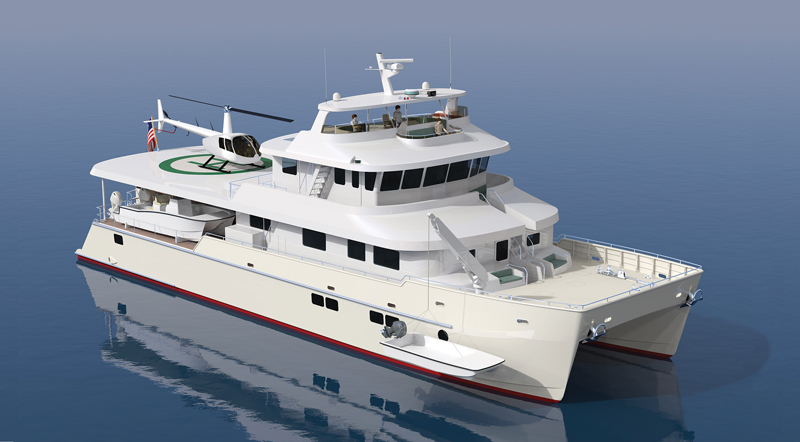
With 110′ LOA, a 35′ beam, and 45′ (33.5m, 10.6m, and 13.7m) of bridge clearance, the H-2 catamaran seeks to make a case for U.S. custom boatbuilding.
Hauling toys beyond the horizon is the raison d’être for a rugged go-anywhere catamaran designed and built in the U.S., a notable exception in the world of big yacht projects.
Gunboat might have left town, but there’s another big catamaran under construction in its old facility in Wanchese, North Carolina. It’s called H-2 , short for Hippocampus 2 , a stout 110-footer (33.5m) that liberally and intentionally quotes from the expedition/workboat vernacular. It’s built from aluminum and was conceived to go to the back of the beyond, where adventure beckons and Vessel Assist doesn’t operate. Aside from commodious and cushy accommodations, the boat offers grid autonomy, ocean-crossing range, and cargo capacity to match the mission of hauling a 26 ‘ (7.92m) tender, a 17 ‘ (5.8m) skiff, a two-person submarine, a four-seat ATV on the main deck, and a small helicopter on the flight deck aft.
The boat was commissioned by Brian Schmitt, 67, a real estate executive in the Florida Keys, who pilots his own plane to commute to the Bahamas, where he keeps Hippocampus , his current 57 ‘ (17.37m) cold-molded wood/epoxy catamaran. I asked him about the jump from 57 ‘ to 110 ‘ . “I never thought I’d have the ability to do that in my own boat until probably the last few years,” he replied, adding that “it would be 120 ‘ [36.58m] if I had to do it today.”
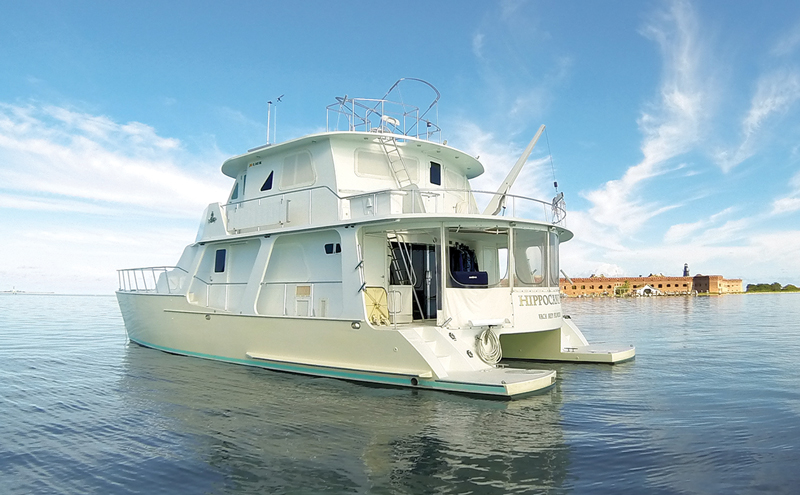
Its predecessor, Hippocampus, built in wood/epoxy, was launched in 2003. At 57′ (17.37m), it is about half as long as H-2, but with 22,500 miles under its keels, it was a useful starting point for designing the new vessel.
Wearing shorts and a shirt with the new boat’s name and logo to our meeting, Schmitt talked openly about his project, which he manages as attentively as his real estate brokerage with 130 agents. Communication is his thing, responding to e-mail questions in near real time (in ALL CAPS) and talking to contractors directly. No project manager.
A passionate diver who habitually explores remote and exotic locales, Schmitt said he was happy with the first Hippocampus , which has three staterooms and cruises at 15 knots on twin 370-hp Yanmars. “It was the vehicle that got our 17 ‘ tender wherever we needed it.” But running the little boat 60 or 70 miles a day lost its charm. “One of the things I wanted was a twin-engine tender that would have more room for dive gear. That ended up being a 26 ‘ Calcutta, so I needed a bigger mother ship.”
With accelerating climate change, the carbon footprint of ships and large yachts is under scrutiny, but hydrocarbons still win when speed, range, and payloads are priorities. While H-2 doesn’t break the mold there, Schmitt pointed to the project’s virtues as a U.S. domestic build. “You can’t complain about global warming when you’re flying around in your G500 jet that’s contributing more CO2 emissions than anybody else in the world,” he said. “You can’t complain about all the boats being built in Germany, The Netherlands, and Italy, and then go buy a boat [there].” Schmidt wanted to build locally, keeping jobs and money in the U.S. Besides, he noted, this approach simplified communications and enabled him to personally check on progress during COVID. Perhaps most importantly, he could pick a team of trusted and compatible mates to turn his dream into a boat.

The vast build hall left vacant when Gunboat left Wanchese, North Carolina.
He selected John Marples, a fellow pilot, inventor, and multihull specialist for the design and Felix Herrin to build H-2 . Both men had worked for him on Hippocampus , and their familiarity helped when meeting today’s challenges, such as damaging trade tariffs that drove up aluminum prices, and a pandemic that killed millions, wreaked havoc on global supply chains, and caused labor shortages in industrial sectors. These factors have conspired to delay H-2 ’s launching by roughly two years and counting.
Advantage Aluminum
A key decision early on was to build in aluminum, which promised a robust structure but required extra steps to deal with corrosion and noise mitigation. “Construction was reduced to something simple—a V-bottom deadrise model, stretched out,” Marples explained. “There wasn’t any benefit to round bilges on an aluminum boat. You’d have to add internal structure to support the flat panels, and it drives the cost and difficulty of construction way up. We’re talking about a speed-to-length ratio of 2 or less, which is not a big deal. His current boat would do a speed/length of about 3, so the extra length means that you’re never really pushing the boat that hard, so shape was not a huge consideration.”
Marples and Herrin go back at least three decades to their mutual acquaintance with naval architect and boatbuilder Dave Dana, who assisted Marples with the hull design for Admiral Pete , a catamaran passenger ferry still serving Puget Sound. Herrin works with different construction materials, but having built crew boats for Petróleos de Venezuela (PDVSA) at Sea Force in Palmetto, Florida, he has spent considerable time with aluminum.

Taking a break during IBEX 2021 are builder Felix Herrin (left) and owner Brian Schmitt. H-2 is their second joint project with designer John Marples.
The structural components on H-2 are 5083-H32 alloy aluminum plate and extrusions of 6061-T6 alloy. Scantlings, materials, and weldment comply with the American Bureau of Shipping’s (ABS) 2016 design guidelines for pleasure motoryachts. Hulls and wing structures have transverse frames and bulkheads spaced on 36 “ (0.91m) centers. Those frames are supported by substantial centerline vertical keels (CVKs) welded atop twin 3 “ x 8 “ (76mm x 203mm) solid extruded-aluminum-bar keels. Intermediate subframes in the forward and aftermost hull compartments strengthen the hulls for operating in ice. Schmitt indicated he wants to traverse the Northwest Passage. For the same reason, there’s 3⁄8 “ (10mm) plate running the length of the boat above and below the waterline.
The topside and underwing plating is primarily ¼ “ (6mm), with areas of 5⁄16 “ (8mm) to strengthen slamming zones in the bow. The main deck plating is also 1/4 “ while the foredeck plate is specified at 5⁄16 “ . The bottom plating is 5⁄16 “ in the aft two-thirds of the hull and 3⁄8 “ forward. “We built all the frames and bulkheads first, then scarfed together the keel sections [and] lined those up on the bunks that we built on,” Herrin explained. “We welded the CVK on top of the keel, then started installing frames.”

Hulls and wing structure have transverse frames and bulkheads on 36″ (0.91m) centers. The hulls are supported by centerline vertical keels.
Herrin said he changed aluminum suppliers midway through the project, sourcing from Bayou Metal Supply , an ISO 9001:2015–certified distributor in Slidell, Louisiana. “We sourced the material from Greece and from domestic suppliers,” said Taylor Smith, who handles Bayou’s sales. Tariffs, he said, did not slow down business much, but the aluminum cost more. “Felix sent cut files. We had the material in inventory, we cut it, processed it on a router, and shipped it on time. Everything flowed well.”
Naval and structural engineering and detailing was contracted out to Van Gorkom Yacht Design in Portsmouth, Rhode Island. “My first responsibility was looking at structures,” Geoff Van Gorkom said. “Given that this is an aluminum yacht, we can do literally all the structures in 3D and have all the metalwork precut before it came into the yard. All the frames and longitudinals and all the primary structure were precut, which saved huge amounts of time.” Van Gorkom said he uses Rhino 3D and some of the numerous modules such as Orca 3D for hydrostatics and hydrodynamics, and 2D AutoCAD to produce construction details.

Helping save time and money, 3D-modeling allowed frames, longitudinals, and the primary structure to be cut before being sent to the building site.
Van Gorkom observed that H-2 is not a fussy high-performance vessel that needs minimum weight to achieve maximum speed. Besides ABS guidelines that address torsional loads in catamaran structures, he also consulted A.L. Dinsenbacher’s paper “A Method for Estimating Loads on Catamaran Cross-Structure” ( Marine Technology , Vol. 7, No. 4, October 1970) to estimate load conditions in beam and quartering seas. “This is going to be a very stiff boat. It’s going to be a very strong boat simply because it has to be, and that was one of the criteria that Brian put out there right from the very start of the project. The boat is sturdy and stout, a strong expedition yacht.”
Van Gorkom also engineered the setup for a folding deck crane housed under a flush hatch in the helideck on the port side to launch and retrieve the two-man submarine or the ATV. “It’s basically an enclosure that opens up, so the crane extends out,” he explained. “It comes up on a telescoping pipe to swing out and pick up something from the side of the boat.” It required support from beams on each side of the crane and cutting a slot in the helideck for the lifting bridle so the loads can move inboard or outboard. On the starboard side, the 5,500-lb (2,492-kg) Calcutta tender is an even heavier load moved by twin overhead beam cranes. The 17 ‘ Twin Vee is launched and retrieved from the foredeck with a 2,500-lb-capacity (1,153-kg) crane.
Catamarans are known to be weight-sensitive, so how will H-2 handle the weight of all the toys and high superstructure? The arch over the flybridge is 33 ‘ (10.05m) above waterline, Van Gorkom confirmed. “Add another 10 ‘ [3.05m] for the radar, mast, etc., so a comfortable bridge clearance would be around 45 ‘ [13.7m].” Marples conferred with Van Gorkom about the effect of the added weight on the center of gravity, which was deemed “almost imperceptible,” Marples remembered. A quick calculation suggests that a 5,500-lb deck load is equal to only 1.57% of a full-load displacement given as 350,000 lbs (158,550 kg).
High Power, Low Noise
Van Gorkom hired engineers at HydroComp to evaluate the design’s hydrodynamics and propulsion systems, including the influence of hull-shape parameters and demi-hull spacing on resistance. HydroComp also offered a speed-power prediction to aid with engine selection and recommended optimum shaft rpm and propeller parameters. Technical director Donald MacPherson, who prepared the report, outlined the process and findings: “Particularly interesting for this project was the use of its novel analytical distributed volume method [ADVM] for the vessel’s resistance modeling. This 2D technique (between parametric methods and CFD) uniquely allows for assessment of the influence of local sectional area curve regions (such as ‘shoulders’ or inflections) in wave-making drag. It also directly evaluates the effects of catamaran hull spacing.” HydroComp helped optimize the hulls by identifying the regions that contribute most to wave-making drag, and securing a 3% reduction in total drag at the design speed by making what MacPherson called “very minor changes to the immersed volume distribution.”

Rob Ayers works on the installation of the starboard engine’s Evolution Marine Shaft System that will be fitted with a 36″ (0.91m) five-blade propeller.
That simulation was mapped to benchmark performances of four similar catamarans, and the process was run for two design variants, followed by a propulsion simulation for partial-load conditions. The hull-spacing study concluded that the originally designed 35 ‘ (10.7m) beam remained suitable despite the boat being 20 ‘ (6.1m) longer than originally drawn. The chosen propulsion system comprises two MTU 10V 2000 M96, 1505-mhp diesels with ZF 3000 flange-mounted marine gears, providing an estimated top-speed range of 20–22 knots, cruising speeds of 12–15 knots, and 10–13 knots for long-range voyaging. Actual performance will be established during sea trials.
The recommended propeller specifications developed by HydroComp were for five-blade models with 36 “ diameters. HydroComp applied PropElements, a wake-adapted propeller-analysis tool, to determine the advisability of installing a nozzle or shroud to restrict transmission of pressure pulses to the hull and to create a more uniform inflow. This would reduce interior noise but would increase appendage drag and power demand. Schmitt said he will wait to see if cavitation or prop noise is an issue before making a final decision.
He invested heavily in noise and vibration mitigation, knowing that an aluminum boat won’t provide the natural sound-dampening of a wood/epoxy structure like that of his first Hippocampus . Consulting with Soundown of Salem, Massachusetts, Schmitt wanted to replicate what worked well on his old boat, starting with the Evolution Marine Shaft System, in which the prop shaft runs in an oil-filled tube and uses roller and needle bearings instead of standard water-lubricated bearings. “You have a lot less shaft noise, but one of the primary benefits of an integral thrust bearing is that it transmits all the thrust directly into the hull, as opposed to pushing on the gearbox or the engine and gearbox combination,” said Sam Smullin, Soundown’s marketing and quality assurance manager. “It allows for a much softer engine mounting, so you reduce the noise from the shaft itself and get a much quieter engine installation, which reduces structure-borne noise.” Because of the relative weight sensitivity of catamarans, Smullin said, “it’s particularly important to do a really good job on the driveline.” His father, Joseph Smullin, president of Soundown and J&A Enterprises Inc., an engineering firm for noise and vibration control, estimated that this could reduce driveline noise levels by 5 dBA to 10 dBA compared to a conventional system.

Clemente Perez, one of Herrin’s build crew, works on the interior. The extensive sound and thermal insulation includes foam sprayed into the cavities.
Soundown also looked at the two 38-kW Northern Lights gensets, which have double-isolation mounts to reduce structure-borne noise. The firm also recommended structural changes to ensure that the mount foundations were as stiff as possible.
Energy from propulsion or generator engines invariably transmits to the boat structure and then resonates through big, flat panels like bulkheads, decks, ceilings, and liners, causing the familiar vibrating rattle. To dampen those vibrations, Herrin said he used Roxul, a lightweight, semi-rigid stone-wool insulation for fire resistance and sound control. His crew also sprayed cavities with Dow Froth-Pak, a quick-cure polyurethane foam for thermal insulation, and installed Sylomer (a microcellular PUR-elastomer) between the structural components and the floors, walls, and panels. “We glued the Sylomer, which is kind of a spongy foam, to the structure of the boat, and then the plywood of the subfloors and walls are glued to that,” Herrin explained, adding that this created a floating interior without any fasteners.
The plywood, called QuietCore, is a composite sandwich panel comprising marine plywood skins and an acoustic damping layer that converts acoustic energy into small amounts of heat that are dissipated. Soundown claims that an 18mm (0.7 “ ) QuietCore bulkhead can reduce noise transmission by up to 10 dBA, an audible reduction 50% greater than with regular marine plywood of equal thickness.
Electricity for a Small Town
Going off grid on H-2 does not mean anyone will suffer, as long as the electrical system keeps powering the boat’s myriad house loads—hydraulic Maxwell windlasses and thrusters; a Webasto air-conditioning system; two full-size stand-up freezers, two refrigerator freezers, and two under-counter refrigerators in the galley, all by Vitfrigo; Krüshr compactors for recyclables and garbage; Headhunter sewage-treatment system; Alfa Laval fuel-polishing system; two FCI watermakers; a complete set of Garmin navigation electronics with full redundancy; and a Böning vessel control and monitoring system.
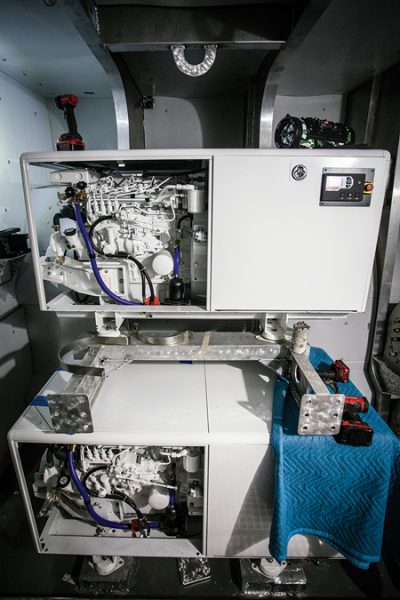
Two Northern Lights 38-kW gensets are the heart of H-2’s AC system, which also includes a 37-kW Atlas inverter to connect to shore power in foreign ports.
Much of the AC side was designed and specified by Ward’s Marine Electric in Fort Lauderdale, Florida, in cooperation with OceanPlanet Energy of Woolwich, Maine, and principal Bruce Schwab, who helped design and integrate the DC components. “Today there’s a big trend in the industry to use shore-power converters as inverters and superlarge lithium-ion battery banks to provide power, at least temporary power, for major loads like air-conditioning, chiller plants, and things like that,” said Ward Eshleman, chairman of Ward’s Marine Electric. “So, rather than using only smaller inverters and synchronizing them and stacking to get additional kW, the trend for the larger vessels is to use shore-power converters as inverters. There is an inverter bus in the main switchboard.”
True to its go-anywhere mission, H-2 was fitted with an Atlas 37-kW inverter to connect to shore power in places that do not serve 60 Hz, 240V single-phase power. “We can take anything from 90V to 400V and pretty much anything from below 50 Hz to the 60 Hz and single- or three-phase,” Herrin explained.
Eight GTX24V315A-F24 lithium-ion batteries from Lithionics are split between a house bank that can run all DC loads for at least 24 hours, and an emergency bank to operate critical DC loads—display screens, radios, nav lights—for 24 hours. The boat is equipped with 10 Solara Ultra-S 160W panels paralleled in two groups of five each, connected to two Victron SmartSolar MPPT 100/50 solar controllers to charge the house bank. Given enough sunshine, solar and battery power should be “capable of running lights and refrigeration but not air-conditioning or heating,” Schmitt said. “Since we will likely spend most of our time in the tropics, we did not believe that solar power alone could do the job we needed.”
OceanPlanet Energy specified four Victron Buck-Boost DC-DC converters, two for each engine, to help charge the house bank from the starter batteries without having to modify the engines’ stock alternators, which would have voided the warranty. “The converters activate based on the input voltage from the starting batteries,” Schwab explained. “With lower rpm, the alternators would not produce enough current to feed both converters without the starting-battery voltage dropping, turning the converters off. Then the voltage will rise, the converters turn on again, drop the voltage, turn off…over and over. Staggering the input voltage cut-in, hopefully starting the converters one at a time, will more smoothly supply power to the house bank across the engine/alternator rpm range.”

OceanPlanet Energy specified the DC system including DC/DC converters and hefty battery banks to power house loads and critical electronics.
There are two 4,500-watt 240V split-phase engineroom-ventilation fans connected to two Victron Quattro 5-kW 24V inverter-chargers configured for 240V/120V split-phase AC loads. They can accept AC inputs from two sources (shore power or generators) and automatically connect to the available source. “In the event of a grid failure or power disconnect, they take over the supply to the connected AC loads by inverting from the Lithionics house-battery bank,” Schwab said.
“It’s more complicated than that,” according to Herrin. “Typically, we’re going to be operating with the A-bus and the B-bus tied together, so we can power everything with one generator. The B-bus actually passes current through the Victron inverter-chargers on its way to the load. We have the ability to split the A-bus and the B-bus and run the A-bus on one generator and the B-bus on the other in the few instances we’re exceeding the capacity of one of the generators. If we lose both generators, then the essential loads are still going to be carried,” meaning engine vents or water pumps.
Redundancy and emergency backups also figured largely in the deliberations of John McKay, manager of the Switchgear Systems Division at Ward’s Marine Electric and point man for this project.
One of his challenges was limiting the voltage drop in the estimated 53 ‘ (16.2m) cable run between engines, which in an emergency allows the starboard engine to be started from the port battery and vice versa. “For a starter group, you can allow a 20% voltage drop,” McKay said and noted that starting the engines requires 720 amps, while the gensets needed only 200 amps. “I was keeping the 720-amp current between 7% and 11% voltage drop, getting up to some pretty good-sized copper. Some sections of the run were 240mm2 [500MCM] cable.” Knowing that the boat is capable of going to high latitudes, McKay recalled his youth and the frigid winter mornings in Massachusetts, “where you can crank a diesel all day long at a low rpm, and it’ll never start. You just need to turn it over one or two times at a higher rpm, and it’ll be running. So, I was making certain that the starter was going to crank at the highest rpm possible and not lose it all to voltage drop.”
Protecting Assets and Finishing the Job
No matter how fast or how far H-2 will travel, corrosion caused by galvanic current between dissimilar metals, by stray currents or by electric fault, is an enemy that needs to be kept in check. That’s the calling of Ted Schwartz, who runs Electro-Guard (Mount Shasta, California). He’s one of the country’s foremost experts on cathodic protection, and also served on ABYC’s E2 Cathodic Protection Project Technical Committee.
“We designed the system and supplied all the equipment and steered them through the installation,” Schwartz said. It’s a 15-amp impressed-current-cathodic-protection (ICCP) system, model 715 A-2, with three anodes and two reference cells. Regarding the boat’s Evolution shaft system with driveshafts running inside an oil-filled tube, Schwartz said: “It was a real challenge because you can’t actually make contact with the propeller shaft on the inside of the boat.” He consulted with Soundown and found a solution. “At the coupling on the inboard end of the tube, a bit of the shaft stuck out through the seal,” Swartz said. “There’s this coupling that Soundown built that fastens to the shaft, and we asked them to provide a surface on that coupling where we could put our silver slip rings on [to provide an electrical connection] to protect props and shafts.”
Every anode can deliver up to 5 amps of current using its own current controller that receives a signal from the main controller, which determines exactly how much current each anode will put out. The entire system consists of three anodes, three current controllers, the main controller, and a separate monitoring station connected to the controller by signal cable. Later, Schmitt also ordered a backup system employing aluminum sacrificial anodes.
On catamarans, the company installs a reference cell aft near the prop of each hull, and an anode on the aft section of each hull, and one anode amidships on the inboard side on one hull.

Chromate, two layers of epoxy, copious amounts of fairing compound, and various primers rendered the surface fair and ready for a yacht-quality paint job.
At the time of this writing, the vessel had been shot with chromate and two layers of epoxy before approximately 500 gal (1,893 l) of fairing compound and 325 gal (1,230 l) of various primers rendered the surface fair and ready for a yacht-quality Alexseal paint job with 35 gal (132.5 l) light ivory, 24 gal (91 gal) stark white, and 2 gal (7.6 l) cordovan gold. Parallel to the exterior, construction was on the home stretch with installation of the crew quarters and the saloon overhead. On the systems side, pressure checks were performed for hydraulics and plumbing.
Since H-2 is a much larger and more complex vessel than the original Hippocampus , with a multitude of systems that need to be managed, monitored, and maintained, I was curious how many crew Schmitt was planning to hire to help run his new boat. He said he consulted with captains and headhunters, and “the consensus is three or possibly four at most. I just completed my 100-Ton Masters and will build time on the new boat as well. We won’t charter and are not accustomed to being cooked for or served or having our beds made and all that. So mostly I’m looking for a qualified captain and engineer to maintain the systems.”
Little surprise that a hands-on operator like Schmitt does not want to cede too much of the game he loves to play. But as big, bold, and broad-shouldered as H-2 will be when she finally emerges from the old Gunboat shed in Wanchese, the proud owner is quick to remind anyone that it’s still “a vehicle to get the toys wherever.”
H-2 : The Designer’s View
H-2 ’s owner, the adventurous Brian Schmitt, has dived into deep caves to see submerged caverns, hand-fed large sharks that would normally view him as food, and spent years in his off-time exploring Caribbean archipelagos in Hippocampus, his current 19-year-old 57 ‘ (17.4m) power catamaran. Nearing retirement age, he gave the order for his “ultimate” yacht.

The foldable hydraulic deck crane to launch and retrieve a two-man electric submarine or an all-terrain vehicle required cutting a slot in the helicopter deck for the lifting bridle.
The first talk about the new design was between the owner, the builder, and me. As we discussed the mission of the boat, it became clear that it would fall into the category of expedition vessel with more guest staterooms, more range, and more room for equipment than his old boat. Brian defined the function of the vessel as a carrier for a 26 ‘ (7.92m) twin-outboard catamaran, an outboard skiff, a small car, and a small helicopter, which needed a flight deck. This vessel was to be used with family and guests while also serving as an operations base for outbound travel by air, land, or sea.
Aside from commodious accommodations, a key requirement was comfortable motion on rough seas. This was to be a catamaran, like his current boat, which offers extensive real estate afloat in a seagoing vessel. The only restriction for the new design was a beam no greater than 35 ‘ (10.6m) to fit the largest Travelift.
The trade-off for overall beam width involves room versus roll motion. A wider catamaran responds more quickly to roll in seaways but with less amplitude, whereas a narrower beam rolls more slowly with slightly more amplitude. The slower roll is preferable as long as overall roll stability is maintained. Roll in catamarans is unlike roll in single-hulled vessels. Because the vessel is supported by two buoyancy chambers (hulls) with distance between them, motion has little to do with roll inertia, but rather with response of the hulls to the seaway. Each hull responds to a passing wave independently by heaving (up/down) and rolling, which is a circular motion around the center of gravity (CG) that translates to lateral motion when standing above the CG, especially high up on the bridge. Power catamarans, unlike sailing catamarans, do not require wide hull spacing to generate righting moment (to support a sail plan), so they can have closer hull spacing, which still preserves sufficient stability, slows wave-response roll characteristics, and takes up less space in port.
One of the expected routes for this vessel is the Northwest Passage over the top of North America. Boats venturing there can expect floating ice, so we added thicker hull plating at the waterline and an ice-separation chamber on the cooling water intakes. We also designed the hull to give the propeller protection by positioning it behind a deep canoe-stern afterbody with no exposed shaft. A rudder horn, below the propeller extending aft from the hull, adds support for the rudder and protection for the prop. This configuration is useful as a hedge against the possibility of grounding. In fact, this boat can be careened on the beach between tides if necessary for repairs. The hull includes a strong, deep, vertical keel structure that allows for blocking anywhere along its length.
Speed and range became the largest determinates of the design. A maximum range of 4,000 miles at 15 knots (enough to cross the Atlantic Ocean) was proposed. Catamarans are easily driven at modest speeds due to lack of significant wave resistance by narrow hulls. A preliminary speed prediction analysis showed that we would be in the ballpark with about 1,400 hp (1,050 kW) and 5,000 gal (18,925 l) of diesel per hull. The final installed fuel capacity is 12,500 gal (47,313 l).

The general arrangement plan shows crew quarters in the hulls, three guest cabins, office, saloon, and galley on the main deck and owner’s suite on the bridge deck level.
A totally new design normally goes through a lengthy proposal and critique cycle between designer and client, especially if the client is knowledgeable and involved. The vessel’s first iteration started at 90 ‘ (27.43m) LOA, but it became evident that it needed more length to relieve a number of ills. After adding 10 ‘ (3.05m) we saw improvements, but it wasn’t until the 110 ‘ (33.5m) length proposal that we felt all the requirements had been satisfied: more slender hull shape, more open interior space, and better placement of machinery and tankage. The flight deck for the helicopter became larger, and the forward superstructure fairings gave the boat a sleeker look. And at 110 ‘ we achieved an efficient length versus waterline beam ratio that reduced wave drag and fuel consumption at the target cruise speed.
While beam remained at 35 ‘ , lightship displacement increased significantly to 230,000 lbs (104,190 kg). Accommodations now include crew quarters for four persons in the bows; three double guest cabins and a ship’s office forward; a large saloon amidships with adjacent galley, and a dive and a storage locker aft on the main deck. The upper deck is arranged with a full-width-bridge steering station forward, protected by a Portuguese bridge, and a master stateroom with en suite bathroom aft. The flight deck extends aft of the master stateroom. Access to the upper deck is by either a staircase from the foredeck, an interior staircase adjacent to the ship’s office, or by stairs from the starboard side deck.
The largest variable weight on the boat is fuel, so the tankage is located amidships to minimize its influence on trim. Engine and machinery rooms aft of the tankage take up the remaining spaces all the way to the transoms. Other amenities include a utility area aft of the crew quarters port side with storage and washing machines, and a walkway through the tank spaces and enginerooms to the boarding decks at each transom. Another late addition is the flying bridge to aid with shallow-water operation by improving the vantage point to see coral heads and other obstructions. Its protective bimini serves as a mounting platform for lights and antennae.
—John R. Marples
Read more Construction , Design , Drawing Board , Yards articles
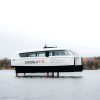
- Candela’s Faith in Foiling Ferries
In the rarefied world of fully foiling electric boats with carbon hulls and appendages, sensor-based digital ride control systems, and hefty price tags, Candela grabbed the spotlight by delivering on… Read more »
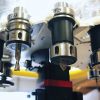
CNC Construction on the Rise
How computer-aided design and software-controlled manufacturing technologies have reshaped custom and semi-production boatbuilding.

Hull Vane: A Wing With Benefits
Typically, military ships are designed and built for specific missions, not to curb their carbon footprint. However, if the Dutch navy serves as an example, that is about to change…. Read more »

Recent Posts
- How Australia II Got its Wings Part 2: Finding Truth in the Tank
- How Australia II Got Its Wings Part 1: Prelude to a Controversy
- Learn Electrical Systems from Nigel Calder
- PRO-SET Epoxy Named an Official Supplier for New York Yacht Club American Magic, Challenger for the 37th America’s Cup
- Companies (83)
- Construction (105)
- Design (157)
- Drawing Board (8)
- Education (24)
- Environment (16)
- Events (20)
- Materials (48)
- Obituary (17)
- People/Profiles (46)
- Products (16)
- Propulsion Systems (31)
- Racing (15)
- Repair (37)
- Rovings (314)
- Short Cuts (3)
- Sponsored Partner News (13)
- Systems (80)
- Task Sheet (1)
- Uncategorized (28)
- Wood to Glass (7)
ProBoat.com Archives
Alubat » The range

Our long distance sailboats
The ovni range.
OVNI – “THE” lifting keel aluminium yacht. OVNIs have been designed for experienced, demanding customers keeping in mind that they are built for intensive use. They are the ideal boats for blue water sailing.
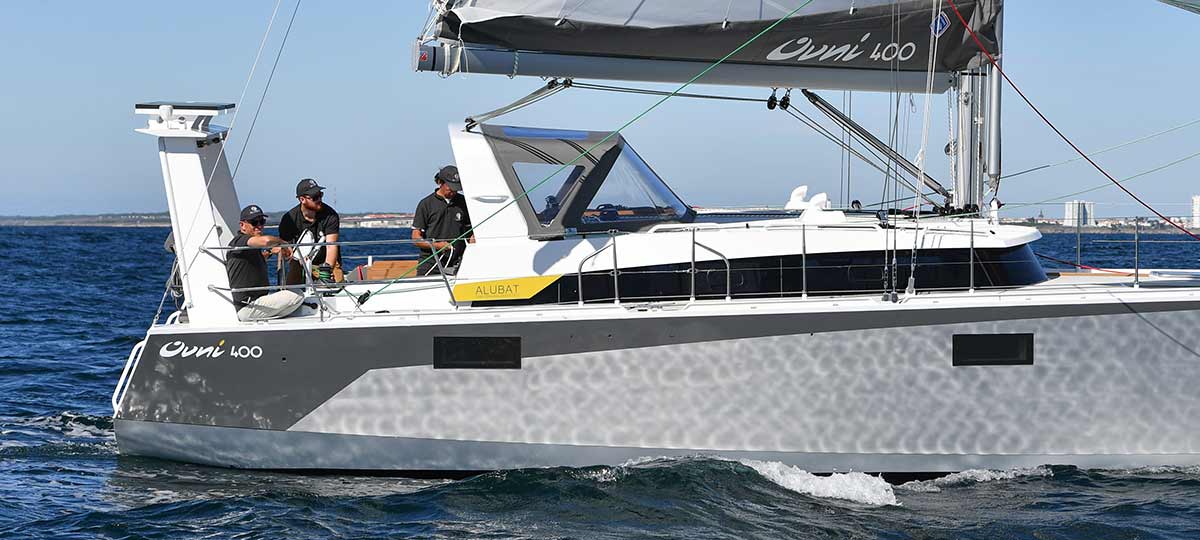
THE CIGALE RANGE
The CIGALE range was created after a simple analysis: Beyond 13/14 m, aluminium boats have less weight than their fibreglass equivalents.
Alubat has therefore developed a range of 100% aluminium boats, fast and efficient at all speeds. The new generation of Cigale met even more emphasis on the performance, comfort and modernity of the boats, thanks to their hulls both shaped and evolving bilge.
- CIGALE 15 QR

THE OVNICAT RANGE
True to the ALUBAT, an aluminium catamaran for bluewater cruising
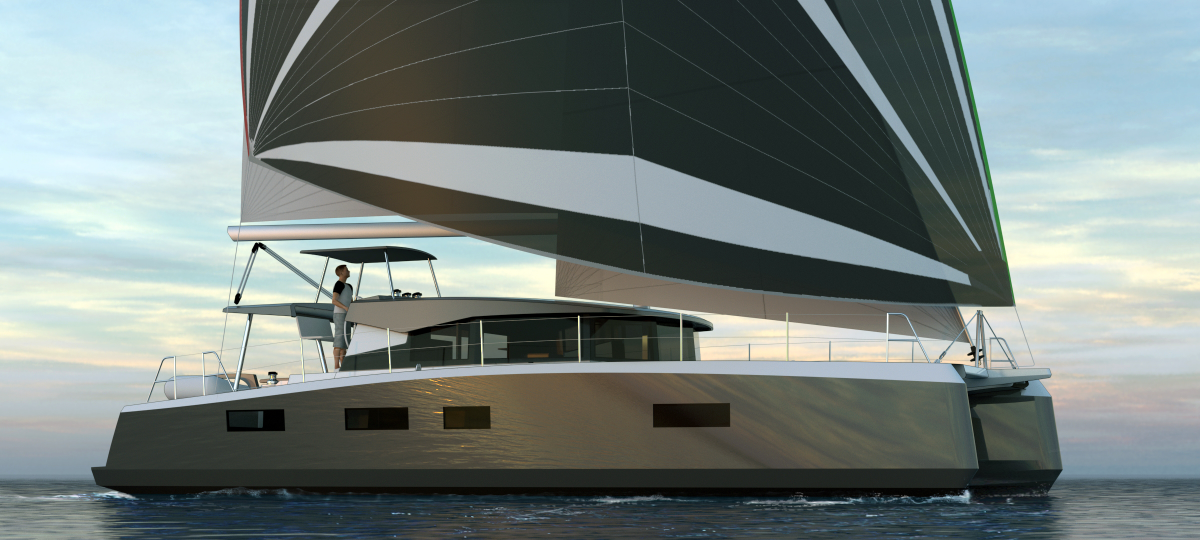
A desire? A project?

Tel. Beratung vereinbaren
Aluminium als Werkstoff
Für den Yachtbau kommen ganz unterschiedliche Materialien zum Einsatz - von Holz über Glasfaser, Carbon bis zu Stahl und Aluminium. Wir hatten die Werkstoffe schon kurz in einem Blogbeitrag vorgestellt, als wir uns während der Planung für unsere Viator Explorer 42 DS damit beschäftigt haben. Doch warum ist Aluminium der ideale Werkstoff im Yachtbau?
Leichtbau ist bei Segelyachten enorm wichtig, da nur eine leichte Yacht die verfügbare Segelfläche in gute Segeleigenschaften umsetzen kann. Ein leichtes Boot verbraucht auch bei Motorfahrt weniger Treibstoff bzw. kommt mit einem kleineren Motor aus. Über die Lebensdauer senkt Leichtbau daher auch die Betriebskosten.
Bis ca. 40 Fuss Länge hat GFK Gewichtsvorteile, da die Aluminiumbleche eine Mindeststärke brauchen, um verzugfrei geschweißt werden zu können. Aber bei größeren Yachten kann Aluminium die Vorteile ausspielen.
Aluminium wiegt etwa 35% von Stahl, benötigt aber ungefähr die 1,5 fache Blechdicke. Der verwindungsfreie und selbsttragende Aluminium-Rumpfbau führt dann im Endergebnis zu einer 29% höheren Zugfestigkeit und zu einer 12,5% höheren Dehnbarkeit im Vergleich zu Stahl. Daher ist Aluminium beim Gewicht und Festigkeit Stahl weit überlegen.
GFK hat zwar eine hohe Zug- und Bruchfestigkeit, allerdings sehr abhängig von der Faserrichtung. Eine Belastung in Querrichtung führt sehr schnell zum Bruch eines Laminats. Typische Belastungen sind Grundberührungen oder Kollisionen oder auch Stöße gegen eine Betonpier bei Wind und Welle. Es kommt dann unweigerlich zu einem Leck und Wassereinbruch.
Ein GFK-Rumpf ist zudem nicht selbsttragend, sondern erhält erst durch die Schoten eine ausreichende Steifigkeit. Dennoch wird er sich bei schwerer See immer verformen. Das "Knarzen" eines Rumpfes ist eine typische Begleiterscheinung. Oft klemmen dann auch Schränke oder Türen. Ein Aluminiumrumpf wäre auch ohne Einbauten absolut stabil und verwindungsfrei. Und natürlich gibt es kein "Knarzen".
Hier ein Beispiel von zwei ähnlichen Schadensfällen. Links der GFK-Rumpf eines Luxuskatamarans, der mit einem Riff kollidiert ist. Rechts der Rumpf einer Aluminiumyacht, die über Stunden von der Brandung auf die Steine am Strand geworfen wurde. Der Katamaran war ein Totalschaden, die Aluminiumyacht ist trotz erheblicher Verformung dicht geblieben.

Hier zum Vergleich der von einer Kollision des Ruders zerstörte Koker einer eigentlich sehr stabilen Malö 46 und der Ruderkoker unserer Viator Explorer 42 DS. Bei solchen Belastungen wird GFK immer versagen, zumal die neuesten Yachtmodelle immer weniger Material verwenden und die GFK-Rümpfe immer dünner werden.

Zum Bau einer Fahrtenyacht ist GFK daher ein völlig ungeeigneter Werkstoff, da eine Kollision oder Grundberührung in abgelegenen Gegenden sehr schnell zum Totalverlust der Yacht führen würde.
Wenn man Argumente gegen Aluminium hört, dann steht Elektrolyse bzw. galvanische Korrosion immer ganz oben. Das ist nicht unbegründet, da es in der Tat einen Aluminiumrumpf in wenigen Wochen zerstören könnte.
Eigentlich ist Aluminium korrosionsfrei, da es mit dem Sauerstoff in der Luft sehr schnell eine dünne Schicht aus Aluminiumoxid ausbildet, die das darunterliegende Aluminium schützt. Die von uns verwendete seewasserfeste Aluminiumlegierung ist zu 100% resistent gegen Salzwasser und wird auch nach Jahrzehnten keinerlei Korrosion zeigen - ganz im Gegensatz zu Stahl, der durch Seewasser komplett zerstört werden könnte. In den Marinas erkennt man Stahlyachten schon von Weiten an den Rostschlieren.
GFK ist hier eher unproblematisch, da es vom Salzwasser nicht angegriffen wird. Allerdings nimmt GFK immer Feuchtigkeit auf und das kann zu Osmose führen. Diese kann über die Jahre erhebliche Schäden im Laminat verursachen.
Doch zurück zur galvanischen Korrosion von Aluminium. Sind zwei Metalle elektrisch leitend verbunden, so wird sich das unedlere Metall langsam im Elektrolyt (bei uns eben Salzwasser) auflösen. Leider ist Aluminium ein recht unedles Metall und steht in der Oxidationsreihe unter Eisen oder Stahl. Fließt nun unbeabsichtigt ein Strom (z.B. bei einer fehlerhaften Verkabelung an Bord), so wird sich das Aluminium recht schnell zersetzen. Die Fotos unten zeigen typische "Ausblühungen" von Aluminium durch Elektrolyse (links) und den Lochfrass im Aluminiumrumpf, wenn man die Ausblühungen entfernt hat (rechts).
Dem kann man natürlich durch eine fachgerechte Elektrik vorbeugen. Der Landstromanschluß ist über einen Isolationstransformator galvanisch vom Bordstrom getrennt. Bei einem fehlerhaften Landstromanschluß kann das also keine Auswirkungen auf das Bordnetz haben. Außerdem ist ein Testschalter eingebaut, mit dem jederzeit geprüft werden kann, ob es Blindströme im Rumpf gibt, die eine galvanische Korrosion verursachen könnten. Zusätzlich schützen sog. "Opferanoden" aus Zink den Rumpf, da sich diese zuerst auflösen, bevor das Aluminium angegriffen wird.
Das Gefahrenpotential ist also beherrschbar, wenn professionell gearbeitet wird. Die zahlreichen Aluminiumyachten, die auch nach Jahrzenten noch wie neu aussehen, sind der Beweis.

Zum Vergleich noch eine typische Korrosion bei einem Stahlrumpf. Der Eigner wollte nur etwas Rost entfernen und hatte gleich ein Leck im Rumpf. Stahlrümpfe rosten von Innen und können daher bei einer Begutachtung von Aussen noch tadellos erscheinen.

Von Aussen kann sich dann nach dem Abschleifen der schadhaften Stelle ein massiver Schaden ergeben, der eine umfangreiche Sanierung notwendig macht. Oft wird so ein Rumpf nur noch durch die Lackschichten zusammen gehalten.

Auch bei GFK-Yachten kann es zu einer galvanischen Korrosion der Metallteile kommen, wenn diese elektrisch leitend verbunden sind. Bei dieser Yacht waren die Kabel der Solarpaneele am Geräteträger durchgescheuert, was den Geräteträger und die Reling unter Strom setzte. Als Folge kam es zu einer massiven galvanischen Korrosion des Edelstahls innerhalb kürzester Zeit.

Aluminium kostet zwar das Dreifache von Stahl (aktuell ca. 1500 EUR vs. 500 EUR je Tonne), was bei den 3,7 Tonnen, die wir für eine Viator Explorer 42 DS benötigen, kaum ins Gewicht fällt (auch unter Berücksichtigung der höheren Preise für die verwendete Legierung und von Blechen). Entscheidender ist aber die einfachere Verarbeitung. Die Bauteile werden automatisch geschnitten und kommen dann als "Puzzle" in die Werft. Aluminiumrümpfe lassen sich schneller schweißen und daher spart man viel (teure) Arbeitszeit ein. Der Rumpf unserer Viator Explorer 42 DS war z.B. in nur 3 Monaten fertig. Insofern ist ein Aluminiumrumpf kostenmäßig mit einem Stahlrumpf vergleichbar.

Für einen GFK-Rumpf muß zuerst eine Negativform erstellt werden. Bei einem Einzelbau lohnt das daher nicht, weil sich die hohen Kosten einer Negativform erst im Serienbau wirtschaftlich darstellen lassen.
Grundsätzlich kann gesagt werden, dass ein Aluminium-Werftbau nicht teurer als eine hochwertige GFK-Serienyacht sein muß. Allerdings bekommt man dann für das gleiche Geld eine ungleich stabilere Yacht mit einem viel besseren Werterhalt.
Wartungskosten
Aufgrund seiner Beständigkeit gegen Seewasser muß ein Aluminiumrumpf nicht lackiert werden. Im Gegenteil, ein fein geschliffener Alurumpf wird auch nach Jahren noch wie neu aussehen. Kleine Kratzer steckt er weg, da sich sofort wieder eine schützende Aluminiumoxidschicht bildet. Man spart sich also die erheblichen Kosten für eine Lackierung. Sollte es mal zu einer Beule kommen, so kann Aluminium gut repariert oder geschweißt werden.

Aluminiumyachten erfreuen sich einer steigenden Nachfrage, der allerdings eine sehr begrenzte Werftkapazität gegenüber steht. Es sind meist kleine Betriebe, die Aluminiumyachten bauen. Die Wartezeiten werden also länger, die Preise steigen. In Verbindung mit der extremen Langlebigkeit und einer hochwertigen Verarbeitung im Werftbau sowie dem sehr überschaubaren Angebot am Gebrauchtmarkt bleiben die Yachten sehr wertstabil. Der Kauf einer Aluminiumyacht ist ein Investment, zumal Bargeld in heutiger Zeit mit seinen Negativzinsen nicht mehr als Wertspeicher dienen kann. Eine gute Aluminiumyacht kann daher als Sachwert verstanden werden, der zudem noch viel Freude bereitet.
Bei den meisten GFK-Yachten sieht es durch ein extremes Überangebot eher schwierig aus. Bei einer typischen Serienyacht verliert man schon bei Unterzeichnung des Kaufvertrages ca. 30% des Wertes. Nach 5 Jahren erfährt man ca. 50% Wertverlust.
Stahlyachten sind eher unverkäuflich. Hier wird man nur über den Preis einen Liebhaber finden. Ein Grund ist eben der sehr hohe Wartungsaufwand, da es ein ständiger Kampf gegen den Rost ist. Ein anderer Grund ist die Bauqualität. Oft sind es Eigenbauten (z.B. die Reinkes), da kann man als Käufer nicht einschätzen, welcher Stahl verwendet wurde, wie die Qualität der Schweißnähte ist oder ob schon beim Bau an einen guten Rostschutz gedacht wurde. Natürlich gibt es auch sehr professionell gebaute Stahlyachten, aber das ist dann eher die Nadel im Heuhaufen. Echter Stahl-Werftbau ist sehr selten geworden und man findet ihn vielleicht noch bei Motoryachten in Holland.
Ein hochwertiger Aluminium-Werftbau hingegen behält seinen Wert. Ein gutes Beispiel mag die rote "Marlin" sein, die 2006 bei Jachtbouw Folmer geschweißt wurde - wie auch unsere "VOLT". Sie lag jahrelang im Surinam-River in Südamerika und rottete im tropischen Klima vor sich hin. Aber nach einer liebevollen Behandlung durch den neuen Eigner sieht sie jetzt wieder aus wie neu. Inzwischen steht sie zum Verkauf . Der aufgerufene Preis von 1,25 Mio. Euro dürfte etwa dem Neuwert entsprechen.

EXPLORING ULTIMATE LOCATIONS IN STYLE
The extreme exploration superyachts by naval yachts.
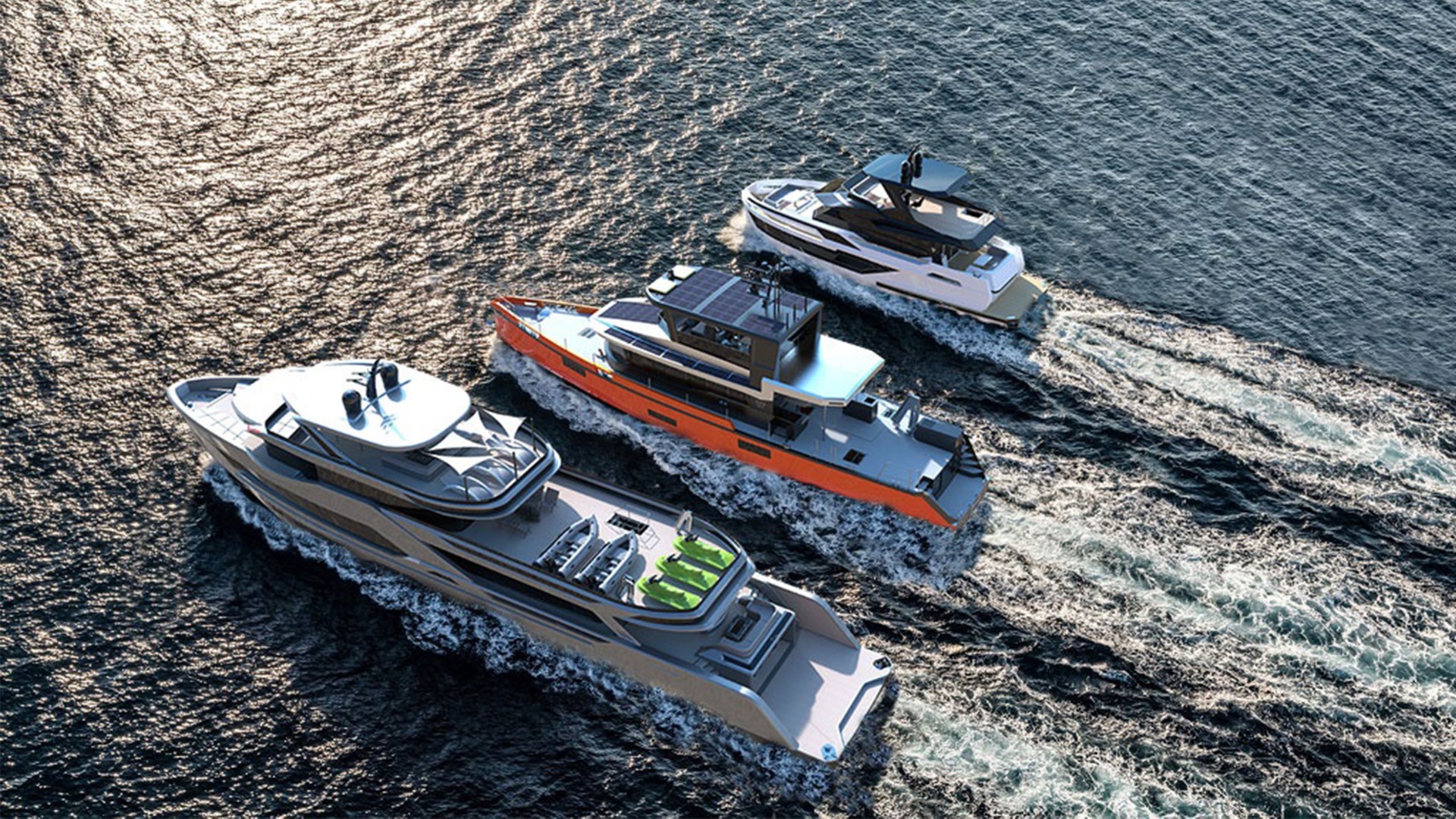
NAVAL SERIES
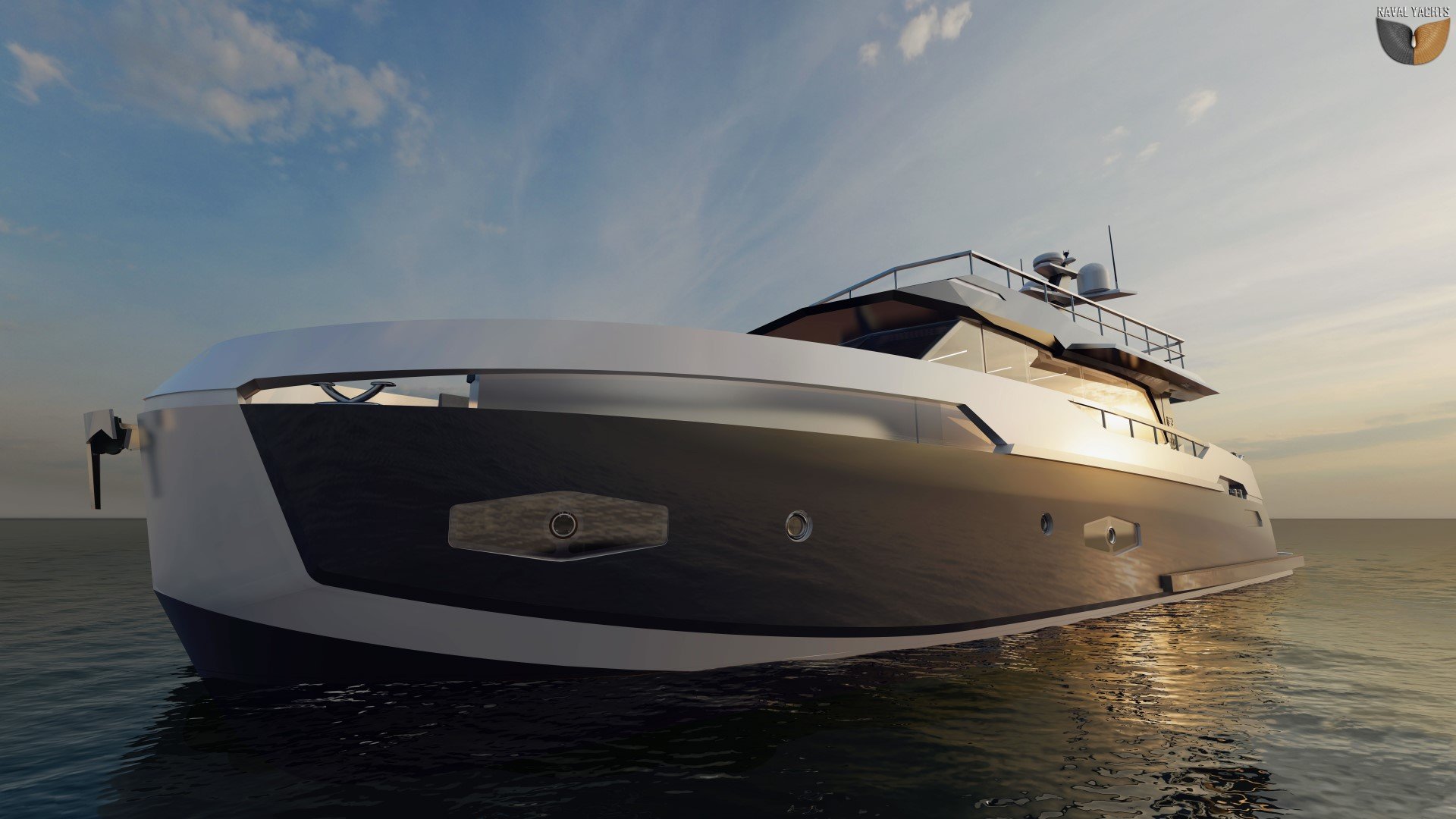
GREENAVAL 60
Aluminium hybrid yachts.
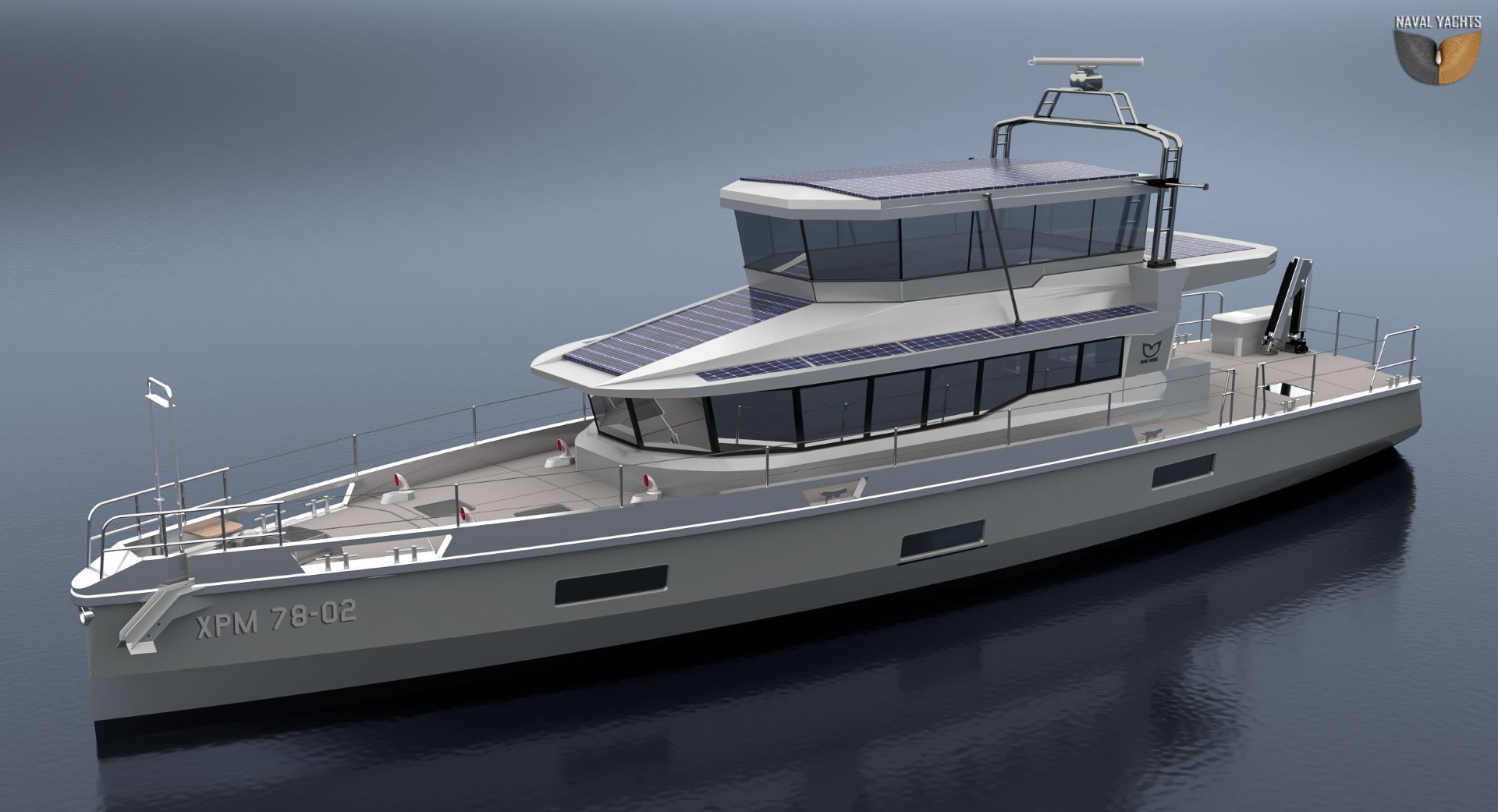
eXtreme eXploration Passage Maker
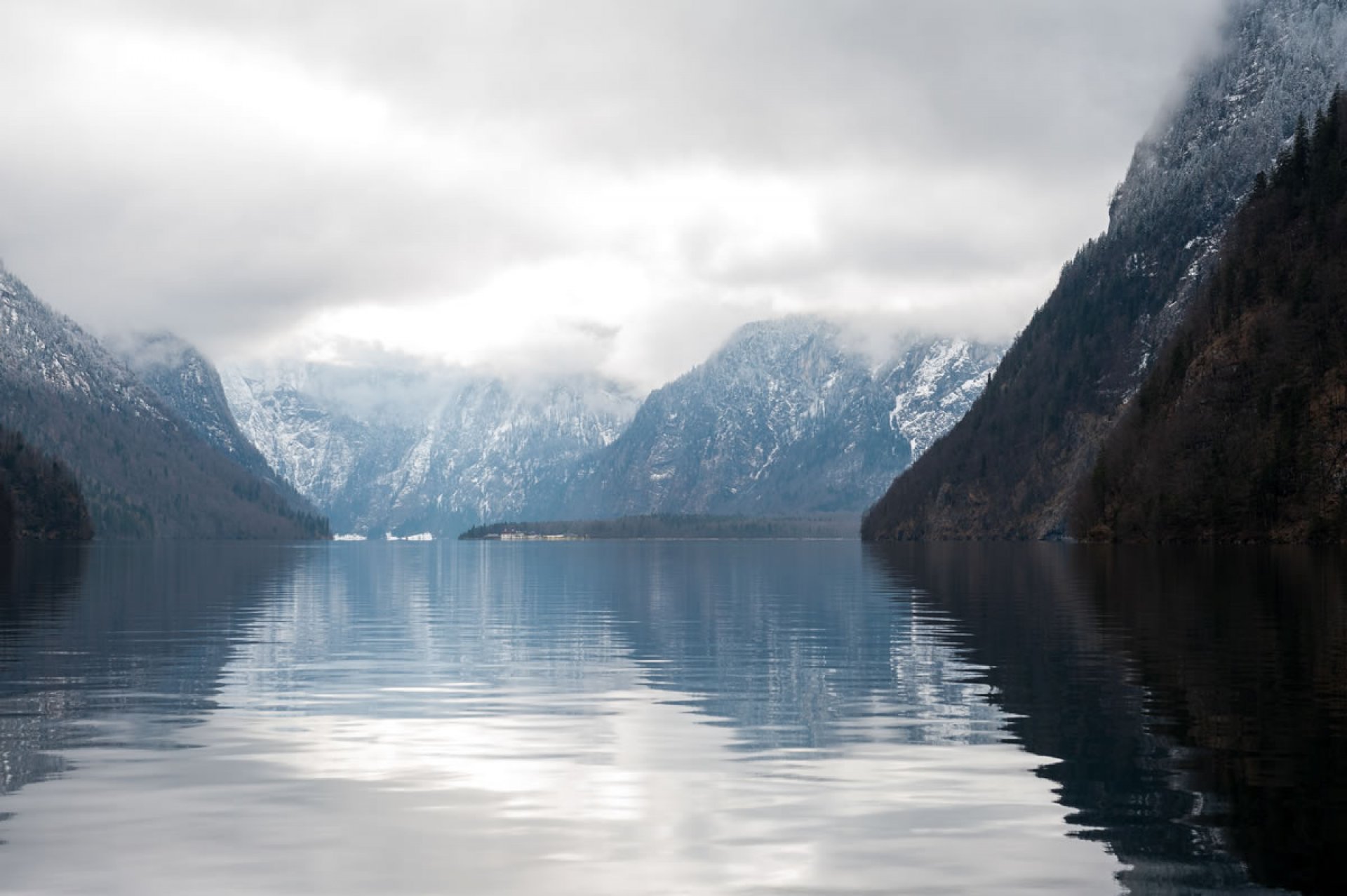
WHY NAVAL YACHTS?

FEATURES OF OUR YACHTS
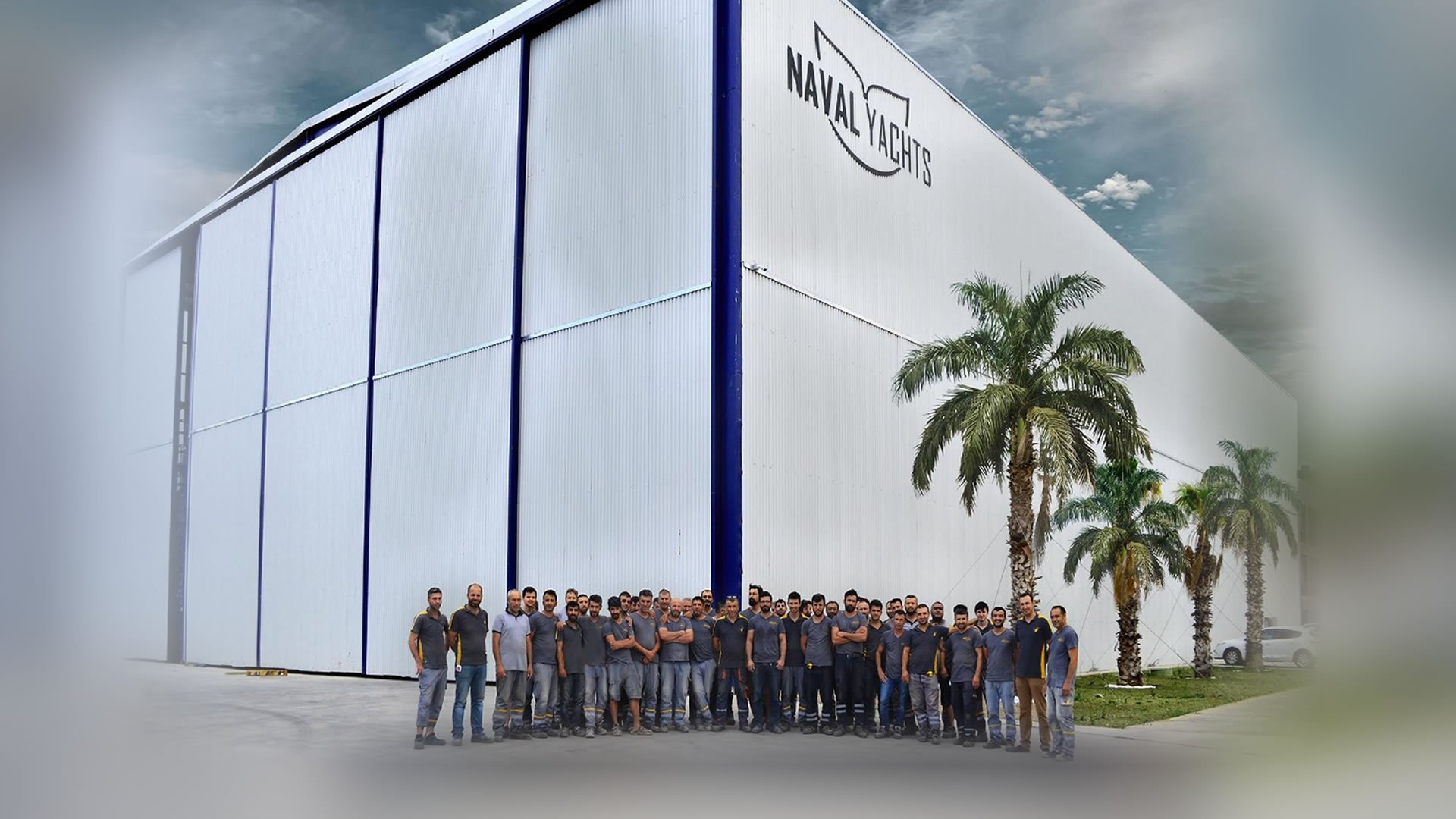
WHERE YOUR DREAMS COME TRUE
Aluminum explorer & expedition yachts, exploring boundless horizons with aluminum explorer & expedition yachts.
At Naval Yachts , we specialize in crafting aluminum or steel vessels designed for long-range journeys, unmatched durability, and eco-friendly performance. Our commitment to reducing maintenance while maximizing adventures sets us apart. Our yachts are built with aluminum or steel for strength and corrosion resistance, ensuring resilience in any environment. They're engineered for fuel efficiency without compromising power and require minimal upkeep, allowing you to focus on exploring the world's most remote corners. Join us to redefine exploration, embark on unforgettable journeys, and create lasting memories with Aluminum Explorer & Expedition Yachts . Naval Yachts Passage Maker Yachts offer a unique "passage maker" experience in the explorer and expedition yacht categories.

Aluminum Strength
With the up front caveat that there is no one “best” material to use when building a boat as they all have their own lists of pros and cons, when you set about building a boat to take on the extremes that Mother Nature can throw at you when crossing the world’s oceans “short handed” with just 1 or 2 people and doing so with the highest safety and comfort, the choice becomes more clear. As with many other choices when designing and building such a boat, this is an extremely personal decision and what counts the most is that YOU have the highest possible confidence in your choice and can set to sea knowing that your boat will be able to endure much more than you.
The reasons of choosing aluminium as your hull material
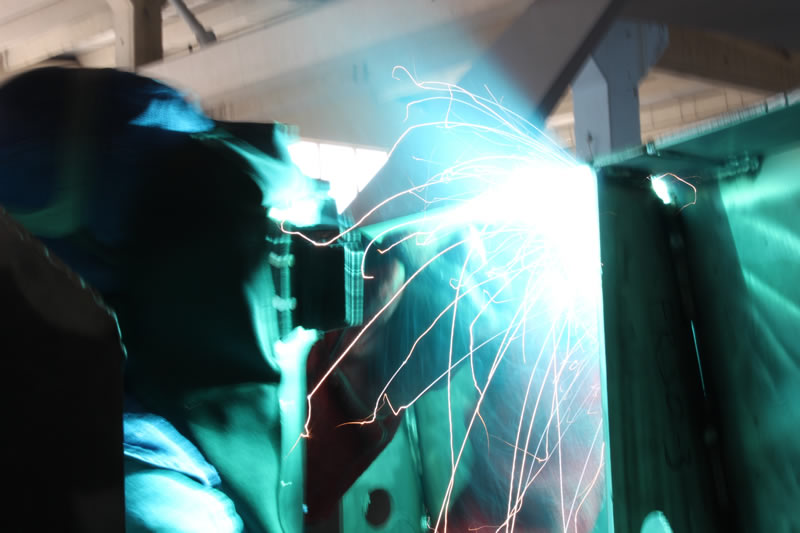
Fuel Efficiency
Fuel efficiency has become one of the most important subject for boat owners and sailors not only because of high expenses but also they pay attention to the environment and nature. Naval Yachts sees these facts and concentrates in new Technologies and engineered studies together with the technical universities and institutions to find and offer solutions.
We use aluminum. A superior material. Light and 100% recyclable. ( Aluminium Yachts )
We have hybrid solutions in powertrain. We have serial hybrid boats launched already with the latest technology.
We use light materials in interior. We make our calculations to reach a light but stable boat in the end.
We design and use the most efficient hull forms in order to get best results with minimum water resistance under the waterline.
Earth is a great planet to discover and experience on a boat. As long as you can. As the sailors would like to discover and see more places, they need enough speed, consume less and bigger fuel tanks.
Our boats can give the chance the sailors to cruise faster and longer without refueling.
Long Range Yachts : Exploring the Naval Yachts XPM Series
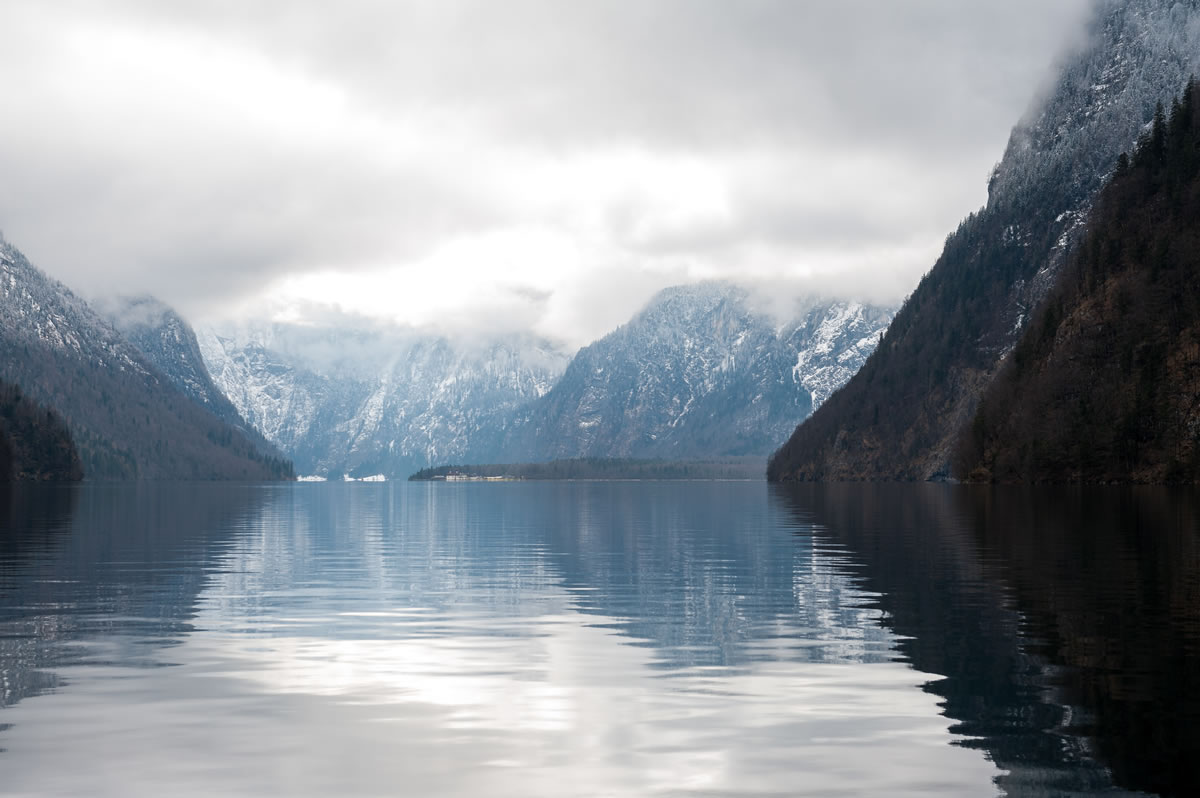
Mission Safety / Safety First
At Naval Yachts, safety is our paramount mission. We prioritize safety first in every aspect of our aluminum yacht production. From design to construction, our unwavering commitment to ensuring the security and well-being of our passengers and crew is at the core of our values
Full Customisation
Naval Yachts is specialised in custom boat building. All our boats are unique and can not be repated because every owner has his own dream on board.
Thanks to our design and engineering team, we can make modifications easily and our experienced production and assemly team can produce and apply these modifications.
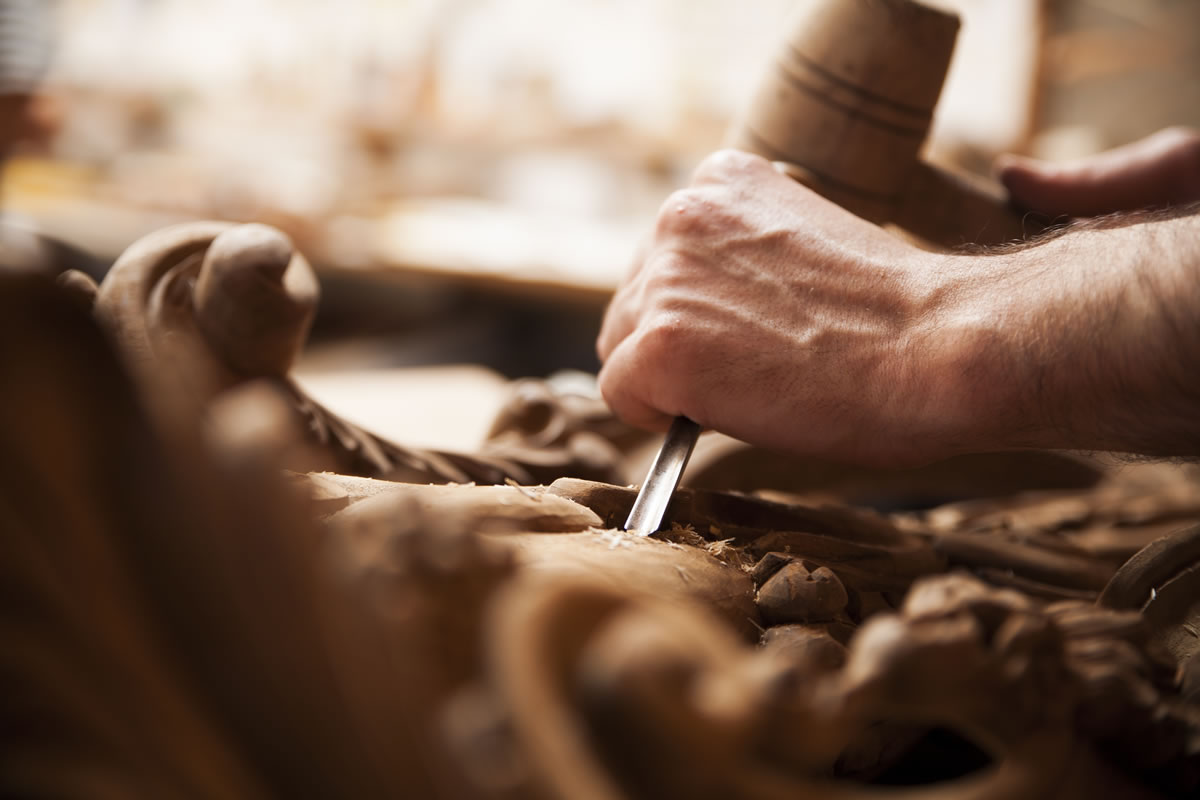
With the up front caveat that there is no one “best” material to use when building a boat as they all have their own lists of pros and cons, when you set about building a boat to take on the extremes that Mother Nature can throw at you when crossing the world’s oceans “short handed” with just 1 or 2 people and doing so with the highest safety and comfort, the choice becomes more clear. As with many other choices when designing and building such a boat, this is an extremely personal decision and what counts the most is that YOU have the highest possible confidence in your choice and can set to sea knowing that your boat will be able to endure much more than you.
The reasons of choosing aluminium as your hull material;
- Extremely easy to work with using regularly available tools such as carbide tipped saws and router bits and to fabricate with readily available welding and bending equipment. CNC cutting with plasma, waterjet or laser works particularly well with aluminium which allows custom designs to be as affordably built as production boats with the dramatic savings in labour time and costs.
- On a like to like boat comparison aluminum boat hulls weigh about 30% less than steel and less weight means a more easily powered hull which pays us back in reduced fuel costs for the life of the boat.
- Our previous all steel sailboat taught us the valuable lesson that robustly built metal boats do not flex or move under the stress and strain of the seas and everything and everyone onboard benefits from boat parts that stay water tight because they don’t move and from the quiet of cabinetry that isn’t being flexed.
- eXtremely low exterior maintenance time and costs when left unpainted down to the waterline as we will do. Left unpainted, bare aluminium quickly forms a hard outer layer of aluminium oxide which prevents any corrosion which will be a major cost savings throughout the life of the boat.
- Highest strength to weight ratio of any boat building material other than composites.
- Future modifications or repairs of damaged parts of the hull can be easily done with either onboard equipment if you know how to weld or by pretty much any welders you will find in any country.
- While steel may have higher puncture resistance in some situations, aluminium is the most pliable and ductile of any other boat material meaning that when (never if) we hit something the aluminium will bend but not break or crack. By using gradually thicker aluminium hull plating from the 6mm we have on our decks to ultimately 16mm below the waterline and 25mm thick at the keel our hull will most likely see us through pretty much any scenario.
- Relatively easy to control corrosion or rot compared to steel, wood, fiberglass or composites.
- Aluminium is very “transparent” in terms of letting you see any damage that does exist as there is nothing which hides below the surface of unpainted aluminium.
- It varies somewhat between different world markets but aluminium boats tend to have a higher resale value than other materials because of all the advantages above.

We use aluminum. A superior material. Light and 100% recyclable.

Get in touch
Please leave your contacts so we can get back to you.


IMAGES
VIDEO
COMMENTS
Explore Bestevaer yachts. Designed by one of the world's most legendary sailors as his private yacht. Brought to you by KM Yachtbuilders. Explore Bestevaer. We are specialized in the building and finishing of aluminum custom built sailing yachts and have over 30 years experience.
Welcome to Hutting Yachts. Since 1975 Hutting Yachts has stood for quality, craftsmanship and performance that has come from a passion for sailing and yacht building. Start to find your exclusive aluminum sailing yacht, meticulously crafted according to your preferences within our semi-custom range, with sizes up to 55 feet.
Explore Bestevaer yachts. Designed by one of the world's most legendary sailors as his private yacht. Brought to you by KM Yachtbuilders. We make custom aluminum sailing yachts and aluminum motor yachts: lightweight, strong, stiff, low maintenance and infinitely customisable.
About our. sailing yachts. From the arctic or mediterranean seas to the pacific and the atlantic oceans as well as closer to our home on the IJsselmeer. Our yachts are found all over the world. It says something about the amount of care we put into our builds.
Explore Bestevaer yachts. Designed by one of the world's most legendary sailors as his private yacht. Brought to you by KM Yachtbuilders. We are a Dutch shipyard with aluminum yachts. Experience, expertise and an eye for detail are what make all the difference in yacht building.
Vanquish yachts are mostly used on blue water so the safety of owners and their guests is central to everything we do at Vanquish. Aluminium has a far better strength/weight ratio than the vast majority of shipbuilding materials and is very difficult to deform. Moreover, the effects of any impact on an aluminium hull are only felt locally, with ...
OVNI 430. Since 1973, ALUBAT have been designing, building and commercializing 100% aluminium boats for blue water sailing. 100% aluminium means that the hull, the deck, the coachroof and the cockpit are all made in aluminium. Everything is welded together with an inside and outside weld, because your safety is priceless.
Aluminium Strongall Specialist - Sailing and motor yachts. Located in Tarare since 1963, META is the manufacturer of Bernard Moitessier's historical JOSHUA. Thanks to the Strongall ® assembly process, patented by the shipyard in 1977, and its unique know-how the shipyard designs and builds sailboats, trawlers, speedboats and other floating ...
Discover the ultimate in custom catamaran aluminium yachts with Cosmopolitan Yachts. Our passion for excellence shines through in every detail, from the cutting-edge hybrid diesel/electric propulsion system to the meticulous construction using top-grade materials and state-of-the-art technologies. ... The yacht's advanced hull form and ...
Garcia Yachts is a French shipyard building high-end blue water cruising aluminum sailing boats, monohulls or catamaran, from 45 to 60 feet.
Alu Marine, a premier yacht building company that was created in 1986, creating bespoke high-end Alu Marine yachts, motoryachts, sailing yachts and high-performance catamarans. It is also a leading manufacturer of industrial and commercial grade aluminium ocean vessels, including passenger ships and ferries, docking boats and barges.
Built in aluminium under the demanding CE-A category, our yachts are rugged, seaworthy and self supporting to brace harsh oceanic conditions, while at the same time provide the shallow draught needed for exploring inland waterways, tidal inlets or even dry out on a mudflat. With Aluminium as our building material of choice, the Korvets are ...
At the same time Ovni, which has built 1,500 shoal draught aluminium monohulls over the past 50 years, was also developing a multihull concept with a 48 design. The first two have already been ...
Designing and building aluminum boats for blue water sailing. The Alubat shipyard has been designing and building aluminum boats for blue water sailing since 1973. With more than 1,600 yachts built and with 50 years of expertise in metal work and carpentry, Alubat has unparalleled experience in the aluminum sailboat market.
Here drawing the 47 ft centreboarder. We have designed a 40 ft centreboard pilothouse sailboat made of aluminium and the 33 ft version is in initial sketch stage. My search for the perfect cruising boat lead me to start the design project and a company called Li Yachts in 2015 in Finland. The name was borrowed from my old aluminium yacht and ...
ALUMAR Yachts offer both professional and home builders cutting files and pre-cut kits for yacht hull construction, helping to save labour costs, reduce material wastage and rental costs while improving construction quality. Following designs are available for both steel and aluminium construction: Dix 38 Pilot House. Dix 38 Aft Cockpit. Echo 38.
An Aluminum Expedition Catamaran. With 110′ LOA, a 35′ beam, and 45′ (33.5m, 10.6m, and 13.7m) of bridge clearance, the H-2 catamaran seeks to make a case for U.S. custom boatbuilding. Hauling toys beyond the horizon is the raison d'être for a rugged go-anywhere catamaran designed and built in the U.S., a notable exception in the world ...
The CIGALE range was created after a simple analysis: Beyond 13/14 m, aluminium boats have less weight than their fibreglass equivalents. Alubat has therefore developed a range of 100% aluminium boats, fast and efficient at all speeds. The new generation of Cigale met even more emphasis on the performance, comfort and modernity of the boats ...
Aluminium als Werkstoff. Für den Yachtbau kommen ganz unterschiedliche Materialien zum Einsatz - von Holz über Glasfaser, Carbon bis zu Stahl und Aluminium. Wir hatten die Werkstoffe schon kurz in einem Blogbeitrag vorgestellt, als wir uns während der Planung für unsere Viator Explorer 42 DS damit beschäftigt haben.
Allures Yachting is a French shipyard specializing in the construction of blue water cruising aluminum sailing boats using a centreboard.
At Naval Yachts, we specialize in crafting aluminum or steel vessels designed for long-range journeys, unmatched durability, and eco-friendly performance. Our commitment to reducing maintenance while maximizing adventures sets us apart. Our yachts are built with aluminum or steel for strength and corrosion resistance, ensuring resilience in any ...
2022 Custom 21 m Aluminum Sailing Catamaran. US$3,602,852. YMB YACHTING LLC | Limasol, Cyprus. Request Info. <. 1. >. * Price displayed is based on today's currency conversion rate of the listed sales price. Boats Group does not guarantee the accuracy of conversion rates and rates may differ than those provided by financial institutions at the ...
2024 Veranda 22 Vista Biew RC. Find Aluminum boats for sale in your area & across the world on YachtWorld. Offering the best selection of boats to choose from.